Case Studies
The studies on this page present an overview of recent and ongoing key projects within the institute's three focal research themes from various angles: research, education and societal relevance.
The Adaptive Ecosystem: Ecological Foundations of Sustainability
Towards a sustainable future for nature and people in East Africa

Increasing challenges currently arise at a global scale to simultaneously achieve the 17 Sustainable Development Goals (SDGs) set by the United Nations in 2015. These SDGs aim to end poverty, protect the planet and ensure that by 2030 all people enjoy peace and prosperity. Especially in different parts of Africa this is however a major challenge, due to combinations of a fast growing human population (doubling every 30 years), resulting demands for more agricultural land, increasing poverty and governance challenges, combined with still remaining unique wilderness that is a global inspiration and heritage. The work of prof. Han Olff in the Serengeti-Mara ecosystem in Tanzania and Kenya highlights how excellent science published in the best scientific journals can be combined with capacity building in developing countries, and on-the-ground changes benefiting both people and nature. He has been able to raise substantial research funding for this work, and is acknowledged as a worldwide leader in savanna ecology.
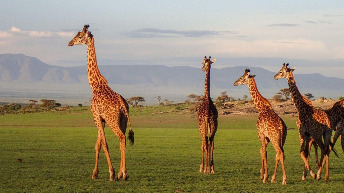
During 2014-2019, prof. Olff co-led the large programme AfricanBioServices in the Serengeti-Mara ecosystem, funded by EU FP7 with 10.5 m€, of which 1.1 m€ landed in Groningen. Representing partner institutes from Tanzania, Kenya, Norway, Scotland, Denmark and Germany, 90 researchers (54 from Africa) worked and were trained in this programme analyzing ongoing climate change, human population growth and land use change affect biodiversity and human well-being, and how this information can be used to derive novel solutions for a future sustainable development. The program led to a range of high-impact publications, including a high profile synthesis publication in the journal Science 2019) with prof. Olff as senior author (Science 363, 1424-1428), a publication that drew international media attention, accompanied by an innovative storymap. Also, the AfricanBioServices yielded as output an ebook reflecting a changed way of thinking on doing scientific research in developing countries, entitled "Tolerant scientists produce better science - better science will save nature". In this ebook, researchers share experiences on best practices for conservation science with an emphasis on 3Cs: Context, Cooperation and Communication. In addition to its impact through original scientific research and capacity building, AfricanBioServices had a strong impact on conservation policies on the ground. The program signaled key threats to future conservation of the unique Serengeti-Mara ecosystem both in Tanzania and in Kenya. In response, the Tanzanian government decided to expand the Serengeti National Park westwards towards Lake Victoria, securing the continued access to freshwater of migrant ungulates also with increasing droughts and declining river flows due to land use change outside protected areas. In addition, a new Game Reserve was established along the eastern border of the Serengeti National Park. Both plans represent first efforts toward restoration ecology in Tanzania. In Kenya, the regional government adopted a series of three management and land use plans to better protect natural resources. All three plans contain AfricanBioservices outcomes as important elements of their scientific basis.
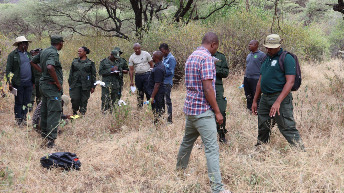
Since 2022, prof. Olff leads a new research program in the region: Corridors, Coexistence, Synergies and Training (CoCoST). The program is funded by a unique range of funds from the private sector, where the Ubbo Emmius Fund from the University of Groningen has joined efforts with the Grumeti Fund, COmON foundation and DOB Ecology to fund a program of 1.4 m€. This covers four PhD students in Tanzania (of which three from Tanzania) and one PhD student from and in Kenya. In addition, the program covers the course Data Analysis for Conservation, in which prof. Olff and his team each year train 25 students from Tanzania and Kenya.
Possibilities and constraints of adapting to climate change in a migrant bird
Currently, most species on our planet are affected by a large diversity of human induced environmental changes. If they cannot adapt to these changes, they will be in trouble and may decline towards extinction. If we want to maintain a living planet for ourselves and all other biodiversity, it is of ultimate importance to understand what the limits are in adaptive capacities of different organisms. This research is ideally carried out over long stretches of time and in natural habitats, as adaptive responses require time and depend on responses of interacting species.
Our long-term research on the adaptive capacities of migratory pied flycatchers to climate change has become a classic example of the difficulties of a species struggling to adapt. This research has attracted broad-scale media attention and featured in Al Gore’s Inconvenient Truth, but also more recently in e.g. the New York Times (2018), or The Economist (2019). In this study we have combined collaborative long-term studies across Europe to show that trends in timing of breeding depend on local long-term trends in temperature, and that populations adjusting insufficiently to climate change suffered severe population consequences. Our recent work shows that over half a century the Dutch population is adapting, most likely through an evolutionary response. In one subproject we investigate experimentally whether long-distance dispersal to areas with later springs is a process of adaptation that has been mostly missed in local long-term studies (NWO-supported PhD-position). In another subproject we focus on how ecological conditions at the species' wintering sites in sub-Saharan Africa may allow or constrain adaptive responses of timing of migration (VENI-postdoc, NWO-supported PhD-position). For this work we have tracked hundreds of flycatchers with miniature archival data loggers across the entire breeding range, addressing how timing of the annual cycle is intertwined with winter habitat usage in Africa, and to what extent variation in wintering sites is determined by nature and nurture. The future of this research will be in adopting a larger food-web perspective, examining how different rates of adaptation across trophic levels will affect the stability of food-webs and its ability to store carbon.
The interconnected Wadden Sea

The Wadden Sea is the largest intertidal mudflat system of the world and is recognized for its unique geological and ecological features, resulting in its protective status as UNESCO World heritage, Natura 2000 and RAMSAR site. The area consists of a large variety of ecosystems, ranging from forests and dunes on the barrier islands, to salt marshes, intertidal mudflats and permanently submerged deeper gullies. The physical and biological connections between those habitats have large consequences for whole-ecosystem biodiversity, functioning and benefits of nature to people. The Wadden Sea is subject to strong current societal debate on the ecological impacts of dredging for shipping lanes, trawling fisheries for shrimp and mussels, and the extraction of salt, shells and natural gas, regarding both their separate and cumulative impacts.
Research by GELIFES aims to connect progress on fundamental understanding of intertidal ecosystems to necessary input in the societal debate on the future management and restoration of the Wadden Sea. In this context, GELIFES and the Netherlands Institute for Sea Research (NIOZ) have a strong history of collaboration on Wadden Sea research projects, shaped by shared staff (Theunis Piersma, Tjisse van der Heide and Laura Govers), affiliated professorships of NIOZ staff at Groningen (Tjeerd Bouma, Johan van de Koppel, Jan van Gils, David Thieltgens, Klaas Timmermans), and provisioning of key facilities (RV Navicula, National Marine Facility, Wader Study facility Texel).
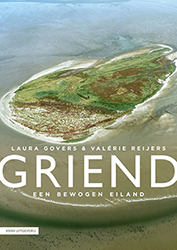
Several large research programs have focused on the importance of intertidal mudflat systems as a fueling station for migratory birds during their stopovers from breeding grounds in the arctic to wintering areas in sub-Saharan Africa (e.g. Metawad PIs Piersma, Olff, Govers; Waddentools-Wij & Wadvogels, PI Govers; Waddentools-Waakvogels, PI Piersma; also see case study BirdEyes). These, and many other animals rely on the high food quality and abundance on the intertidal mudflats, studied in detail in the now finished projects WaddenEngine (PIs Olff, Eriksson), Waddensleutels (PIs Olff, Eriksson) and Mosselwad (PI van de Koppel). In these projects, ecosystem engineers, i.e. species that modify their own environment, play an essential role by shaping the landscape and facilitating a plethora of species. Apart from clear examples such as reef-building mussels and oysters, this also covers tube building worms (PIs Govers & Olff) and seagrasses (projects Zeegrasherstel I & II and Herstelmaatregel Griend (PIs Govers, van der Heide, Olff, Piersma). The latter resulted in the successful restoration of ~650 ha of seagrass in the Dutch Wadden Sea and a popular science book on the history and ecology of the island Griend. Research on ecosystem engineers continues both on the barrier islands with a focus on dune-forming vegetation (project Builders on the Beach, PI van der Heide), salt marsh-forming vegetation and bioturbation (PIs Smit, Berg), on intertidal mudflats (Building with Ecosystem Engineers, PI van der Heide; Seagrass restoration Wadden Sea, PI Govers, Eriksson) and in the subtidal areas (Waddentools-Waddenmozaïek, PIs Govers, van der Heide, Olff) and Waddentools-Swimway, PIs Eriksson, Govers).
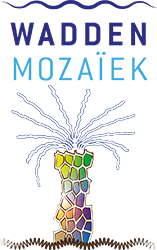
Importantly, this shift to the subtidal areas of the Wadden Sea in the Waddentools projects Waddenmozaïek and Swimway, cover the ecology of the least studied areas of the Wadden Sea ecosystem, and is in that sense the last missing link between the different habitat types. Where Waddenmozaïek focusses on distributions and functioning of macrozoobenthic species such as shellfish and polychaetes, and their link to abiotic conditions, Swimway focuses on the fish species and habitat use, as well as migration, analogous to the flyway approach of the migratory birds. In addition, several projects focus on the ecological interaction networks (trophic and non-trophic) and long-term ecosystem changes of the salt marshes in connection to intertidal ecosystems (PI's Smit, Berg, Olff).
Due to the high interest in, and use of the Wadden Sea area, all these programs have a strong connection with local stakeholders, governmental agencies and NGOs. Researchers from all programs are therefore continuously involved in stakeholder engagement. In particular the governmental agencies and NGOs are frequently involved in committees and as co-financiers of research projects to improve the exchange of knowledge and increase the chances of scientific findings being implemented in science-based management policies.
Wadden Sea: Swimway
The creation of hard barriers between land and sea is among the largest ecological catastrophes northern Europe has experienced in modern times. This can be seen as a historical catastrophe with not only major ecological consequences, but also societal dimensions as it affected the cultural heritage of villages and erased traditional livelihoods. The estuarine gradient from marine to freshwater habitats – from intertidal mudflats, via salt and reed marshes, to peatlands – once characterised the coastal zone and shaped the biodiversity of the Netherlands. Today, however, this gradient is almost entirely erased due to land reclamation and the construction of dikes and dams. Effects on biodiversity are equally dramatic and tightly interlinked with loss or degradation of functions. Not only have estuarine species seen their habitats disappear, but the whole ecological strategy of migrating between different aquatic habitats have been impaired and many organisms today are cut off from areas needed to complete their life cycles, with fish as clear examples. In 2020, we investigated the average change in abundance of 1406 populations of 247 species of migratory fish from all over the world, and found 76% decline between 1970 and 2015 (The Living Planet Index, Deinet et al. 2020). In Europe, the corresponding decline was 93 % (based on 408 populations of 49 species) - highlighting the catastrophic consequences for a whole ecological guild caused by barriers in northern Europe.
In the project Swimway, which is a collaboration between University of Groningen, The Netherlands Institute for Sea Research and Wageningen Marine Research, we address the degeneration of function of the Dutch coastal zone for fish. Fish display a great variety of life strategies. Many fish use the Wadden Sea during some part of their life cycle; as a nesting area or nursery, but also as a stopover habitat on their migrations between marine offshore waters and the great freshwater deltas inland. Thus, the Wadden Sea is a swimway that sees many fish passing or stopping to complete their life cycle. The aim of Swimway is to understand the value of different habitats in the Wadden Sea, to be able to provide advice on how to manage declining fish populations. The project includes five PhD projects. In Groningen we focus on understanding the value of salt-marshes and underwater reefs for fish, and we work in close collaboration with relevant stakeholders to produce advice on how we can mitigate negative human impacts on our fish community.
Towards agroecological, regenerative and nature inclusive agricultural landscapes
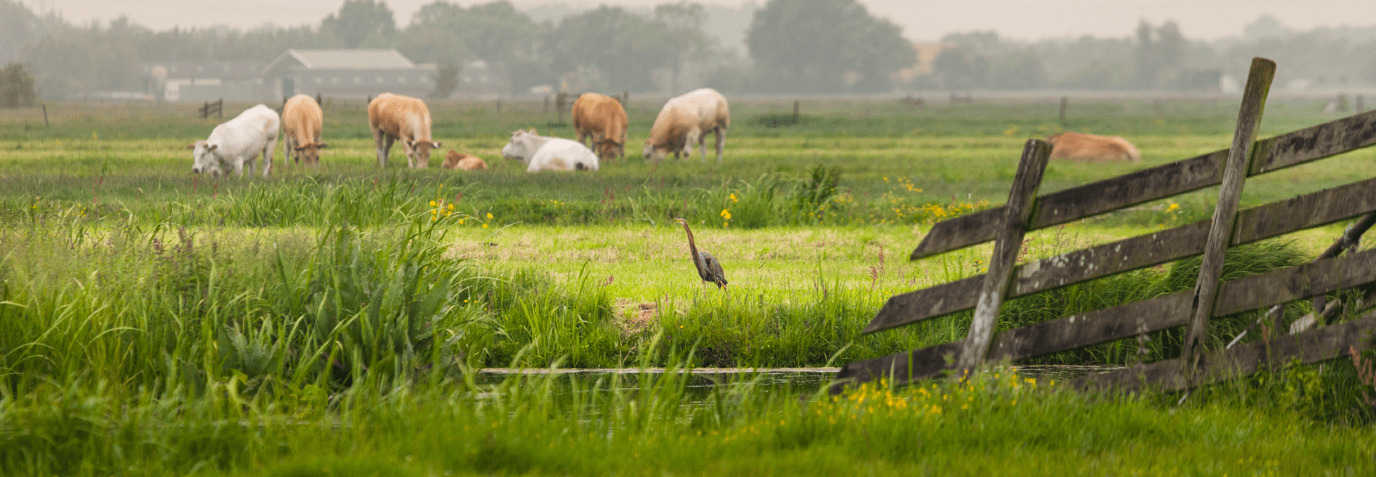
The transition of agri-food systems from circular nature-driven, solar energy-based to linearized industrialised agriculture driven by external energy, has generated many ecological, environmental, climatological and societal problems. Current agriculture contributes to high energy consumption per unit of food energy produced, degrading soils, large greenhouse gas emissions, phosphorus and nitrogen leaching, large water footprint, pesticides, loss of biodiversity, deterioration of landscapes, and foods with reduced nutritional value (impacting health). Moreover, the financial outlook for many farmers is grim, while social appreciation of farmers has declined. Agriculture in the north of The Netherlands is no exception to these global trends, with the aggravating consequences of high land and labour prices and elevated degrees of financial indebtedness among farmers.
Yet the northern region of The Netherlands, comprising the provinces of Friesland, Groningen and Drenthe, has a great potential for agricultural production thanks to its favourable environment in terms of soils and climate, and to the know-how of a highly professionalised and innovative agricultural sector. The region also hosts a large and vibrant food industry, and centres of knowledge and excellence. The diversity of soils and environments in the North means that a large diversity of agricultural activities can take place, with the potential to create a solid base for a more local and circular agricultural sector. These regional features also represent a complexity of ecosystems and habitats with the potential to host a wide range of biodiversity at different scales on the landscape, if properly managed, and a diversity of livelihoods and food traditions that represent an important cultural heritage.
Biodiversity has been declining in the North over the last four decades, chiefly as a consequence of agricultural intensification. Additionally, the nitrogen crisis that affects The Netherlands nowadays is also played out in the North, no less because the region receives the excess nitrogen ‘exported’ from other regions of the country. A redesign of the agricultural systems and landscapes is urgently needed in the north of The Netherlands, a region that has the potential to become an example and lead the way towards sustainable food production, playing a key role at national and international levels.
Exploring solutions together with farmers
Pablo Tittonell, Raymond Klaassen and Ruth Howison have developed a number of regional initiatives involving farmers, farmer advisory firms and regional knowledge organisations (e.g. Van Hall Larenstein School; Open Teelten Valthermond WUR) to address the challenges the agri-food system faces in the north of The Netherlands. Their aim is to contribute to developing resilient, multi-functional landscapes that can host biodiversity while meeting farmers’ and societal needs, through exploring and testing new agricultural practices, technologies and business models together with farmers. Biodiversity is seen as an integral part of a production landscape, where it contributes to delivering ecosystem services of local and global importance.
The AReNA innovation platform (since 2021)
In October 2020, a group of farmer representatives and regional knowledge brokers approached recently arrived Prof. Tittonell to establish a research collaboration with farmers in the north of The Netherlands. This is how the AReNA (Agroecology, Regenerative and Nature-driven Agriculture) innovation platform started. The aim of this platform is to induce a paradigm shift towards agroecology and regenerative agriculture, recognized by the UN (cf. UN Food Summit solution clusters) as sustainable solutions to address the above-mentioned problems. This is done through (i) regenerative agriculture demonstration projects on farmers’ fields to support co-creation and co-learning activities between scientists, students, farmers and relevant stakeholders in the region; (ii) training activities for farmers and students; and (iii) advocacy and communication activities to provoke a change in societal and political mind-set on the present agri-food system and the potential for agroecology, regenerative and nature-driven agriculture. A total of 116 farmers from Friesland, Groningen and Drenthe provinces have already signed up to participate in the platform.
Life-IP project Grassland Bird Habitat (2021 – 2031)
Reversing the curve of biodiversity decline requires a thorough redesign of production landscapes, particularly those that are crucial to the life cycle of key species. Western Europe hosts a wide diversity of grassland-nesting birds, which spend the initial phases of their life cycle in the region before migrating to warmer climates. Current intensification of grassland management reduces habitat quality and hence bird populations drastically, through simplification of grass species diversity, high N fertilisation rates as slurry, drying out and hardening of soils, low water table, less feed availability for birds (earthworms, insects), pesticide use, nest destruction through mechanical grass mowing instead of direct animal grazing. The project aims at restoring grassland bird habitats by engaging with farmers to develop and test alternative farming business models and management practices, while measuring their impact on bird population dynamics. The project has case study regions in Friesland (The Netherlands) and Lower Saxony (Germany) and a budget of 26 million euros.
Regio Deal Nature Inclusive Agriculture Northern Netherlands (2021-2024)
The Northern Provinces initiated the Regio Deal ‘Nature Inclusive Farming’ to stimulate the transition to more sustainable farming systems in the Northern Netherlands. The Regio Deal knows a bottom-up approach where farmers and other stakeholders designed avenues towards nature-inclusive farming in seven core areas. Ideas and principles are applied and tested in a number of front-runner projects. Dr. Klaassen (RUG) is leading the knowledge consortium of the Regio Deal (Kadaster, WUR Van Hall Leeuwarden, Aeres, Terra, Proefboerderij Kollumerwaard) for knowledge transfer, education, training and advice. In addition, RUG participates in three front-runner pilots, in which it is responsible for ecological monitoring. Front-runner projects turn out to be notably successful acceleration points where farmers, scientists, policy makers and other stakeholders harmonise. An important additional task of the knowledge consortium is the monitoring of the governance of the transition (together with Hennie van der Windt-RUG).
Postdoc and PhD projects
Barbara Prack McCormick (2023-2025) is a postdoc researcher exploring the impact of regenerative agricultural practices on soil biodiversity, to inform practices better suited to habitat restoration and soil-mediated ecosystem services. Luis Barba Escoto (2021-2025) is a PhD candidate exploring the relationship between landscape complexity and habitat quality as well as the effectiveness of different agri-environmental measures at restoring bird populations. Jean-Yves Duriaux (2020-2024) studies in his PhD project the willingness of farmers to adhere to conservation strategies and their perception and preferences to opt for alternative subsidy mechanisms oriented towards landscape restoration. Ciska Nienhuis (2023-2027) is developing a PhD proposal to assess ecosystem services and economic results associated with nature inclusive agricultural practices, with a focus on crop diversification.
Teaching and training
The experience and knowledge generated through these initiatives is translated into two postgraduate courses: (i) The course ‘Ecology of Sustainable Farming’, which is an elective course within the MSc Program Ecology and Evolution; and (ii) the summer school course ‘Designing Sustainable Landscapes within Regional Food Systems’, which is attended by both RUG postgraduate students and international participants. Furthermore, about 5-8 MSc students conduct MSc projects in this research field. Competition for the limited number of MSc projects on this topic is fierce, indicating a great interest among students in this applied research field.
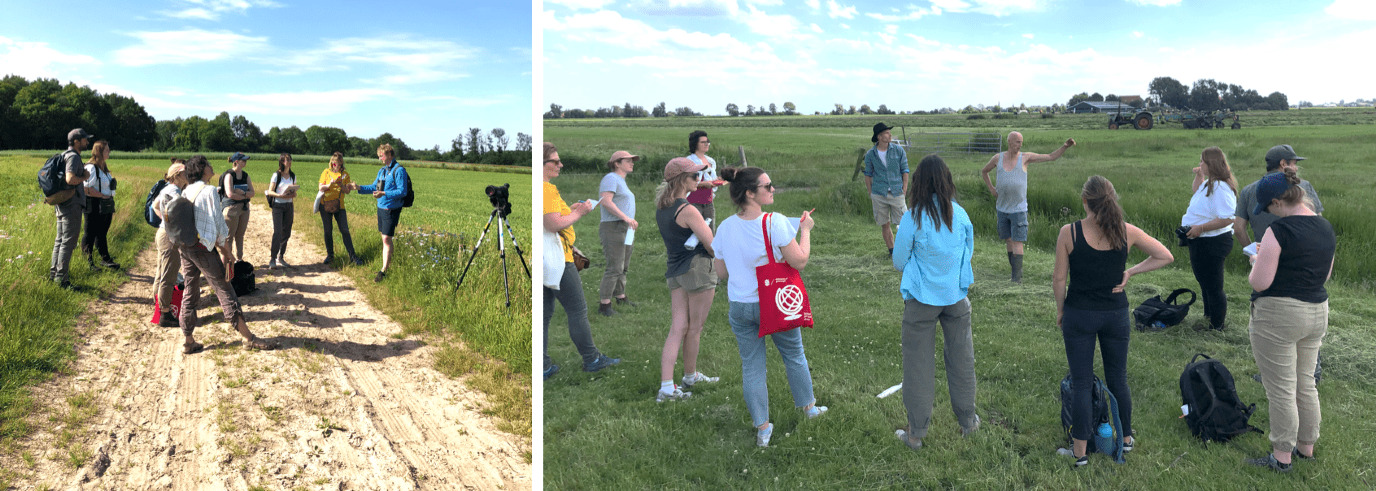
Insects to feed the world
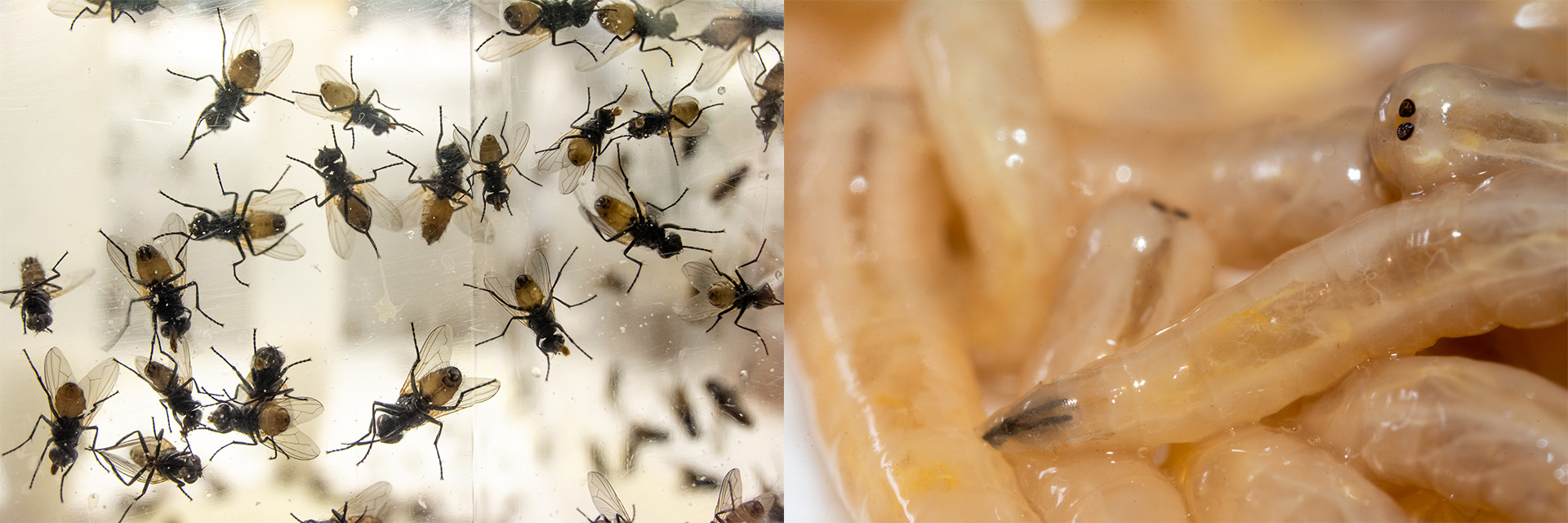
With the expected growth of the human population towards 9-10 billion people by 2050, a substantial increase in global food production is required. This poses a problem because higher food production requires more land and water, and will further induce climate change. Current feed production for livestock competes with food production for humans (e.g. cereals and soymeal) or relies on resources that threaten biodiversity (e.g. overfishing for fishmeal). For a novel circular and sustainable approach to feed production, insects provide excellent opportunities because various species can be reared on organic residual streams as part of a circular economy. Insect production for feed is a fast growing industry.
Professors Joana Falcao Salles, Bregje Wertheim and Leo Beukeboom are part of the NWO-NWA funded InsectFeed consortium coordinated by M. Dicke (WUR Entomology) with partners from economy and philosophy, as well as from insect production companies, and animal rights and consumer organisations. This interdisciplinary InsectFeed project aims to (1) investigate insect production, especially focussing on insect health, insect welfare and the intrinsic value of insects, (2) investigate health and welfare of livestock that is fed with insects and (3) conduct an economic analysis of the value chain development. i.e. the development of an integrated set of activities to deliver a valuable product. Fly larvae are important insects to be used as feed because they have an excellent nutritional quality and can be reared sustainably on a variety of organic residual streams. We focus on studying the production biology of the Black Soldier Fly (BSF) (Hermetia illucens) and the House Fly (HF) (Musca domestica). In Groningen, we investigate the microbial diversity, immunology and behaviour of the housefly in the context of its mass production and welfare.
The housefly inhabits septic environments which constitute rich sources for microbial acquisition. Although the HF is associated with many microorganisms, it is yet unknown which are always recurrent and/or necessary for the housefly’s development. Postdoc Anna Voulgari-Kokota is conducting microbial surveys to identify which microbes are recurrently associated with the housefly gut throughout all life stages of the species’ life cycle and to what extent their presence relies on environmental acquisition routes. We find that houseflies might lose microbial diversity when reared in controlled environments, but can maintain a consistent set of bacteria, which might be necessary for its development. On the other hand, its fungal microbiota are mostly acquired through diet. We are expanding microbiological surveys to different abiotic conditions and different diets, such as those used in industrial rearing settings
Insect immunity is regulated by multiple signal transduction pathways, and both the HF and BSF genome contain many more immunity genes than, for example, Drosophila. Together with PhD student Maaike Vogel we are investigating the expression patterns of immunity-related genes, to determine whether they can serve as early diagnostic markers for disease and help prevent detrimental effects of microbial infections in rearing settings. We also investigate whether we can fortify their immune defences. We do this with flies reared on various substrates (e.g. sugar or fat enriched) and under various conditions (e.g. temperature and humidity).
Mass rearing of flies raises concerns about animal welfare, but there hardly exists any knowledge about how insect welfare needs to be defined and measured. PhD student Marrit van der Bruggen investigates housefly behaviour with the aim to develop a welfare protocol for both adult and larval houseflies in mass-rearing systems. She focuses on how larval aggregation behaviour increases food intake and faster development due to increased temperatures. She also investigates how flies respond to noxious stimuli (e.g. high temperatures) in order to develop a monitoring system for insect welfare.
The knowledge base for using insects for feed is growing rapidly, but it requires an integral and interdisciplinary approach for developing this new industry in a sustainable way. It poses diverse opportunities to recycle and upgrade organic waste to produce high-quality animal proteins, to remediate contaminated waste streams, or to convert manure into protein feed and organic fertiliser. Thus, developing insects as mini-livestock can contribute to reducing our environmental footprint. In GELIFES, we combine our expertise on insects and microbes to contribute to the development of this novel circular agricultural production system.
Fathom the salty clay

Soil degradation as a result of salinization and desiccation is a worldwide problem which is also increasingly affecting farming lands along the Wadden area. The deteriorating quality of the increasingly saline clay soil has a negative impact on, among other things, the high-quality cultivation of seed potatoes, the most important economic pillar for farmers in this area. So far, approaches to tackle salinization have mainly focused on improving the salt tolerance of crops, physical and abiotic soil properties and water management, for example by retaining and using fresh water. However, the multi-year project 'Fathom the salty clay' focuses on the biotic soil properties, the aim of which is to improve the soil quality of saline clay soils via an innovative cultivation plan that can make crops less sensitive to salt. The project monitors various aspects of soil quality in relation to the yield of potato varieties and other crops and gathers practical knowledge about how degenerated saline clay can be converted into vital soil on which sustainable salinity-tolerant arable farming can take place.
This research will be carried out in the 'Double Dyke' area near Bierum, where the Province of Groningen and Waterschap Noorderzijlvest have set up a testing ground for saline agriculture. For the construction of the second inland dyke, the topsoil layer of 70 cm was excavated, resulting in a degenerated loamy clay soil between the two dykes providing a unique starting point for pilot studies aimed at salt-tolerant agriculture and soil regeneration.
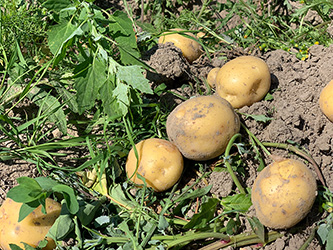
After a preparatory year (2021) in which a number of potato varieties and soil-improving crops were tested, three sub-projects will investigate the influence of (i) crop rotations, (ii) multi-year cultivation of plant mixtures and (iii) fertilization with seaweed or sludge on the development of soil quality. The physical (structure), abiotic (fertility), and microbial properties of the soil will be analyzed annually. In the crop rotation pilots, these soil properties will be related to crop physiological characteristics (salt tolerance) of six potato varieties. In the pilots with multi-year cultivation of plant mixtures, the development of the soil quality will be monitored for four years, with the idea of testing the cultivation of potatoes in the following five to eight years.
In this project, by means of an integrated research approach into soil quality, soil biome and variety/crop characteristics, practical cultivation solutions are sought that can counteract the decline in soil quality in the Wadden area and comparable clay soils elsewhere in the world.
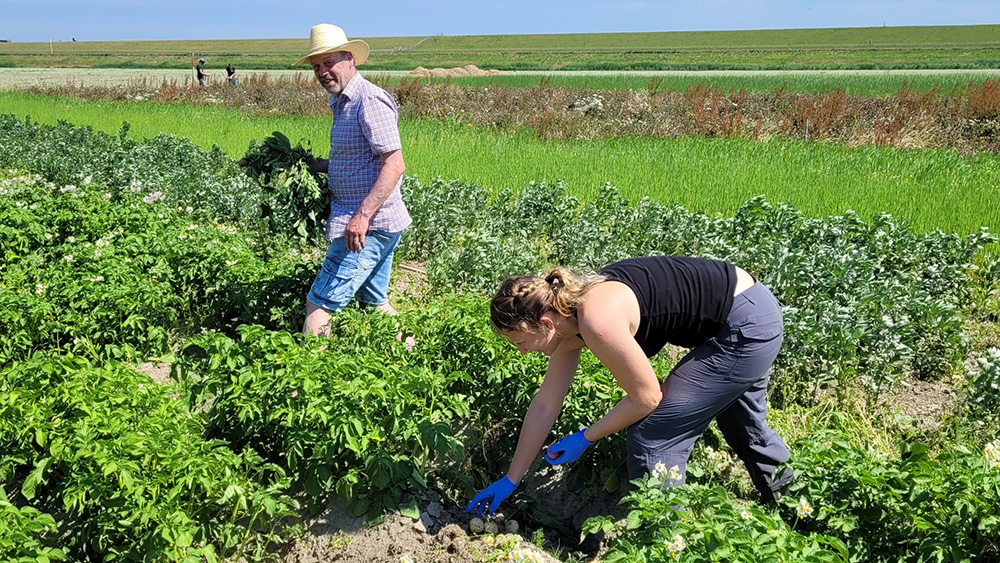
This research is funded by a four-year grant from Waddenfonds, which has been jointly awarded to dr. Kira Tiedge and dr. Jan Henk Venema from GREEN in collaboration with Dr. Erik Meijles (Physical Geography - Faculty of Spatial Sciences) and Dr. Stefanie Vink (Greenfinch Research). Furthermore, this project is supported by partners from the potato sector, seed breeding, arable farming, government and green education at Van Hall Larenstein Leeuwarden.
The Adaptive Organism: Eco-Evo-Devo Foundations of Adaptation
How theoretical research can help conservation policy: From island biogeography to species protection
Since 2015 prof. dr. Rampal S. Etienne and affiliate assistant professor Luis Valente (Naturalis) have developed a new theory of island biogeography which has not only profoundly changed the scientific field, but has also led to recommendations for conservation policy.
In 2015 Etienne and Valente, along with Albert Phillimore (University of Edinburgh) launched a new modeling framework called DAISIE which is an acronym for Dynamical Assembly of Island Biota through Speciation, Immigration and Extinction (note that the daisy (sunflower) family is known as a remarkable radiation of flowers on islands). In this framework, Etienne and colleagues connected the seminal theory of island biogeography founded by Robert MacArthur and Edward Wilson in the 1960s to phylogenetics; they developed a mathematical approach which allows one to estimate crucial rates of speciation, immigration and extinction of island species from the evolutionary trees representing relatedness between species as commonly reconstructed from DNA sequence data. With these rates one can then simulate the processes by which species colonize and diversify on islands. This allowed them to determine whether ecological communities on islands are in equilibrium (until now commonly assumed by the theory of island biogeography) and they found that this is not always the case. Island communities may not have reached an equilibrium state, but may be underway to even higher diversity, which shows that islands are even more important for biodiversity than they already are (they host a disproportionally large number of endemic species). Furthermore, the framework also allowed them to study the effects of human-induced extinction of species on islands (the dodo being the iconic example) and quantify this in terms of a new measure: loss of macroevolutionary time. They found for several islands and taxonomic groups that anthropogenic extinctions would require millions of macroevolutionary to restore the pre-human diversity. This shows the enormous impact that humans have: even if the islands were no longer disturbed, diversity levels would never reach the prehuman levels because most islands will have submerged by then.
Valente, Etienne and coworkers also found empirical evidence for a relationship between speciation, colonization and extinction rates and island area and isolation, based on.bird phylogenies on 41 archipelagoes worldwide with an extension of their DAISIE framework.
The work on island biogeography DAISIE was not only funded by VIDI and VICI grants awarded to Valente and Etienne, respectively, but has also attracted several PhD students who brought their own funding from various countries (China, Portugal, UK) and resulted in double doctorate trajectories. Valente and Etienne will set up an entirely new course on Island Biology in 2023/2024 where DAISIE will play an important role.
MARM: Modelling the Evolution of Adaptive Response Mechanisms

In 2018, F.J. Weissing received a prestigious 5-year ERC Advanced Grant for the research programme “Modelling the Evolution of Adaptive Response Mechanisms” (MARM). In the past, evolutionary theory has developed powerful methods to analyse and predict the course of evolution under natural selection. However, all these methods assume that there is a simple relationship between phenotypic traits (like eye colour) and the underlying genes (like genes whose variants induce different eye colours). Due to the genomics revolution, we know that the majority of genes do not directly encode phenotypic variants but instead are involved in regulatory processes. Indeed, virtually all processes in living organisms are regulated in one way or another. For example, genes are switched on or off by gene-regulatory networks, hormones regulate all kinds of physiological processes, the immune system is triggered by the advent of pathogens, and animal behaviour is modulated by the central nervous system. All these regulatory processes allow organisms to function in different environments, to cope with predators and diseases, and to rapidly adapt to changes in their environment. It is of considerable importance to understand the evolution of such “adaptive response mechanisms”. Such understanding may, for example, allow us to predict whether and how organisms are able to cope with climate change, under which conditions stress tends to result in disease, and which kinds of viruses are particularly challenging to our immune system.
Unfortunately, the evolution of regulatory processes is not well understood. Classical models fail because regulatory genes have very different properties than the structural genes (like genes for eye colour) studied thus far by evolutionary theory. Most importantly, the properties of regulatory genes cannot be understood in isolation, as these genes are typically embedded in regulatory networks. Depending on the other genes in the network, each variant of a regulatory gene can therefore have a multitude of different effects. As a consequence, even simple regulatory processes have many (actually millions) degrees of freedom. Last but not least, mutations of regulatory genes can have surprising and often counter-intuitive effects.
To unravel the principles underlying the evolution of regulatory processes, Weissing’s group studies diverse response mechanisms (ranging from the control of development to the functioning of the immune system to the role of learning and social sensitivity in behaviour) by a combination of mathematical analysis and computer simulations. The project has already yielded very interesting findings, observed in the broad spectrum of response mechanisms covered. For example, the evolution of regulatory mechanisms is orders of magnitude faster than evolution in the traditional models. This leads to novel insights into the interplay of ecology and evolution, the dynamics of epidemic diseases, and the dynamics of social interactions. A second insight is that the evolution of response mechanisms often leads to several, coexisting “solutions” to an evolutionary problem. This provides a new explanation for the diversity of ways organisms tend to cope with their environment.
Chronobiology
Chronobiology has a strong societal relevance for health and biodiversity. The study of internal rhythmicity that allow organisms to anticipate day-night cycles and seasonal changes, with implications for a wide range of fields including sleep research, ecology, evolution, physiology, behavioral neurobiology, and clinical applications. It can form a crucial role within GELIFES to bridge the gap between the neuroscience and evolutionary ecology groups. The Chronobiology unit consists of two local PIs (prof.dr. Peter Meerlo and prof.dr. Roelof Hut), extra-ordinary prof.dr. Marcel Visser (NIOO group leader) and associated collaborator dr. Kamiel Spoelstra (NIOO researcher), and dr. Marijke Gordijn (CEO and founder of the company Chrono@Work; 0fte appointment at GELIFES). Appointments in 2023 include dr. Nicole Gervais (assistant professor) and visiting professor dr. William Schwartz (Neurobiology, Natural Sciences, University of Texas, Austin, USA).
1) Sleep (Meerlo, Hut)
Chronobiology at Groningen had an early and continuing influence on the sleep field with the development of the two process model of sleep regulation (Fig.1), in which the role of the circadian clock on sleep regulation was clarified (Daan, Beersma & Borbely 1984; 1812 citations). This model is still prevailing in the field of human sleep research and has inspired later work in our group. Sleep research by the Meerlo-lab currently makes use of modern EEG loggers, that allow for sleep recording in free living birds and mammals (Fig.1).

2) Effects of light on sleep, performance and biodiversity (Hut-lab, Chrono@Work, Visser, Spoelstra)
Light is the most important external signal for biological clocks. Specialized photoreceptors provide this environmental information to the central clock in the hypothalamus, which subsequently regulates daily timing in behaviour, physiology, and mental performance. Light can also have direct influence on many of these processes including attraction of insects and disturbances of seasonal rhythms (Fig. 2). Our unique human facility allows us to isolate subjects from external time information to study the spectral influence of light on alertness and performance and isolate clock regulated processes (Fig.2).

3) Stress causes circadian syndrome (Meerlo, Hut)
Over the last years a new and important research line describes the reason why chronic stress is unhealthy. The key to this finding is that chronic stress, through adrenal activation, shifts the circadian clock in organs by creating an additional drive in clock gene expression. This creates an internal jet-lag or shiftwork-like situation, which explains why stress makes us sick.
4) BioClock consortium (Hut-board member, Gordijn, Meerlo, Visser, Spoelstra)
The BioClock project (10MEuro Chronobiology consortium funding) is aimed at societal influence based upon application of chronobiological knowledge in (1) Societal, (2) Clinical, and (3) Ecological domains. This can lead to (1) healthier lifestyle, optimization of lighting, (2) more effective medical treatment, and (3) preservation of biodiversity (through reduction of artificial lighting). In this Dutch consortium 5 scientific institutes (LUMC, RuG, UVA, Erasmus MC, NIOO-KNAW) collaborate with 13 companies (Philips Lighting, Signify, Peira, Exmore, Seaborough, MediLux) and 5 associations (GoodLightGroup, DarkSky, Agricultural), 10 governmental policy organizations, and 10 knowledge and Health Care associations for a healthy life in our 24h economy and a reduction on its impact on our natural environment. In addition, the BioClock Academy initiative publishes freely accessible educational lectures on the importance of Chronobiology on YouTube as effective public outreach.

5) Public outreach and societal influence (Hut, Gordijn, Visser, Spoelstra)
The chronobiology spin-off company Chrono@Work (CEO Gordijn, +4 employees) started in 2013 and forms a very successful bridge between industry and fundamental research (grants obtained include EUHorizon2020 ‘EnlightenMe’, EUinterreg Food2020 ‘NiteBite’, PCH EcoSystems ‘SleepInSync’, PBM Seaborough). Resulting in close collaborations with lighting companies, industry (shift work), and policy makers (Dutch Health counsel).
Chronobiology receives a lot of societal attention (popular science, medical education days, science exhibitions, national radio and television interviews and prime-time shows; Fig.3). This allowed us to address matters like awareness for the right for sleep, later school times, abolishing day light savings time, and the importance of light pollution (Spoelstra, Fig.3). This resulted in advisory roles to city governments on light pollution (Spoelstra), National advisory committee light pollution (NSVV, Spoelstra), the Dutch Health counsel (governmental advice, Gordijn), the Dutch ministry of Internal Affairs (Hut, Gordijn), and a permanent data generating Chronotype exhibition at the Nemo Science Museum in Amsterdam (Fig.3).

The Seychelles warbler

The Seychelles warbler is a small passerine endemic to the Seychelles archipelago in the Indian Ocean, that has for many decades been used to study the evolutionary ecology of cooperative breeding. The entire Seychelles warbler (Acrocephalus sechellensis) population on Cousin Island has been extensively documented and sampled at the individual level for nearly four decades. Seychelles warblers virtually never migrate from Cousin Island, and annual resighting rates are extremely high. The study system therefore provides a rare opportunity to monitor the survival, reproduction and lifetime fitness of the entire population over multiple generations. Environmental quality (food availability in each warbler territory) has been measured for all individuals and mapped in detail during every year of the study period. These long-term field data provide a fabulous wealth because they enable the clarification of general principles, beyond the influence of erratic and random environmental quirks.
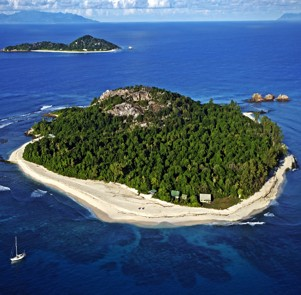
The Seychelles warbler is a rare conservation success story. In the 1960s, only ca 29 Seychelles warbler remained in one hectare of mangroves on Cousin Island, with populations on other islands wiped-out due to habitat loss and invasive predators. Given the vulnerability of a species confined to a single small population, and that warblers virtually never move to other islands themselves, birds were successfully translocated from Cousin to four other suitable islands (led by Nature Seychelles). The world population of Seychelles warblers is now estimated at 2750 adult birds across five islands, and the conservation status of the Seychelles warblers has been reduced from endangered to vulnerable (IUCN 2013).
Our work on Seychelles warblers has substantially advanced the fields of behavioural ecology, social evolution and molecular ecology in at least three areas:
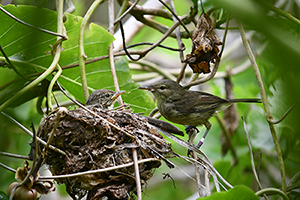
(i) The evolution of group living and cooperative breeding
Offspring often delay dispersal and remain in their natal territory. We discovered that the main cause of such delay is the degree of habitat saturation. However, the amount of insect prey available in a territory is also an important factor. For a young bird, the breeding success and survival benefits of remaining and helping in good territories (high food abundance) outweigh the benefits of independent breeding in poor areas, and offspring from good territories rarely disperse to breed in poor areas. Our work therefore confirmed two much-debated alternative hypotheses on the ecological factors influencing delayed dispersal and led to a new synthetic view.
(ii) The evolution of sex allocation
We showed that mothers in high-quality territories mainly produce daughters (the helping sex), while in low-quality territories they mainly produce sons (the dispersing sex). For breeding pairs living in high-quality territories, having helpers increases their reproductive success and survival, but in low-quality territories helpers compete with breeders for food resources. This skew in offspring sex ratio is striking, because birds were previously thought not to be able to adjust the sex ratio at birth (as in birds sex is determined by chromosomes). We did not only find out that Seychelles warblers can adjust the sex ratio of their offspring, but in a series of meticulous studies, we also unravelled that they do so in a highly adaptive manner. Our research (which includes evolution of sex allocation on other systems) has stimulated wider interest in how vertebrates manipulate offspring sex ratios.
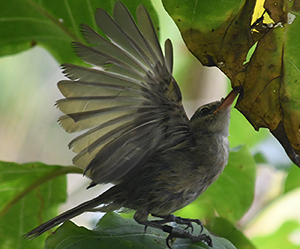
(iii) Senescence
We showed that in cooperative breeding systems breeders reduce their parental care and increase in health (lower oxidative stress, higher body mass, less susceptible for diseases) when assisted by helpers, resulting in delaying breeder senescence and enhancing life expectancy. We also showed that helping deteriorates health and accelerates senescence in helpers, thereby reducing life expectancy. We found that within-individuals extra-pair parentage of both males and females declines in older age, and that males are cuckolded less in older age, furthering understanding of the evolution of infidelity. We also demonstrated intergenerational effects of parental age on offspring fitness, with mothers having daughters with reduced lifespan and lifetime reproductive success as the mother became older. These intergenerational effects can therefore have important effects on population and evolutionary dynamics.
Our ongoing work focuses on the questions such as the genomics of senescence and inbreeding, causes and consequences of divorce, whether group cooperation is adjusted to changing environments, and whether such facultative sociality is an important adaptive mechanism enabling individuals to adapt to rapidly changing environments. The in-depth knowledge of the warbler system creates a unique opportunity to study the interplay between social, environmental, transgenerational and genetic effects in a natural setting to investigate their eco-evolutionary consequences.
Ecophysiology and evolution of endosymbioses
Anthropogenic climate change is drastically increasing levels of atmospheric carbon dioxide, much of which is absorbed by the oceans and re-reflects solar radiation back toward Earth through the greenhouse effect. This results in a domino effect of warming temperatures, increased acidification, and deoxygenation, termed the “deadly trio”. These stressors have been implicated in every global mass extinction, yet almost nothing is known about the combined effect of these stressors on organismal performance, especially amongst understudied taxa like marine invertebrates, even though they make up the vast majority of animal life in the oceans. The Ecophysiology and Evolution of Endosymbioses (EEE) Lab headed by Dr. E. Laetz has pioneered multi-stressor laboratory experiments to study the individual and combined effects of the “deadly trio” stressors on the physiological performance of various marine organisms. Using a state-of-the-art computer controlled aquarium facility, Dr. Laetz and her students subject organisms to a variety of different stressors and then measure a multitude of different physiological processes to determine which stressors affect critical cellular processes. This project provides a fundamental understanding of stress physiology and why some organisms are particularly vulnerable to the effects of the “deadly trio” stressors. With this knowledge, EEE researchers hope to predict which organisms can cope with climate change via plasticity or adaptation and which species will likely go extinct.

Key findings from recent investigations conducted by the EEE lab include:
- numerous clades of marine invertebrates can withstand far higher temperatures than previously predicted by established patterns that correlate temperature sensitivity to latitude (i.e. tropical species are not always more sensitive to temperature increases than their temperate counterparts, which contrasts a long-held and seemingly well-supported biological hypothesis);
- animals that have oxygen produced in their tissues by symbiotic algae that photosynthesize have a significant advantage when faced with acute thermal stress indicating that oxygen availability plays a key role in determining an organism’s thermal tolerance;
- an iconic Dutch species of solar-powered sea slug (an animal that steals chloroplasts from its algal food and profits energetically from photoysynthesis) will survive the predicted temperature increases for the North Sea, as long as its food alga also survive.
All of these projects were conducted primarily at GELIFES from 2020-2023, by Dr. Laetz and 11 MSc students. This work has resulted in four manuscripts that have been submitted for publication and nine manuscripts that are in preparation for submission to scholarly journals. This work was funded by the NWO through a Veni research grant awarded to Dr. Laetz has been presented at international conferences.
Whale conservation genetics
The first whale, a humpback whale, Per Palsbøll encountered was amid gigantic icebergs in the Disko Bay in West Greenland back in 1987. Not only was it his first whale but he had to collect a small piece of skin with a dart fired from a cross bow. He had developed the tissue collection system together with his master project supervisor, Finn Larsen then at Greenland Fisheries research institute. The US whale researchers on the same research cruise subsequently invited Per to collect samples in the Caribbean for his PhD project on genetics of large whales at the University of Copenhagen. An ever-expanding network during and after his PhD project developed into a large North Atlantic and global collaborative network in a career long joint effort by Per Palsbøll and his partner Martine Berube together with Finn Larsen.
At first whales may seem a highly exotic research target. However, three decades of research in whales yielding tens of thousands of samples collected from free-ranging whales has served as the basis for novel methodological developments and provided insights of broad relevance. Whales are elusive animals, spending most of their time below the ocean surface migrating thousands of kilometers every fall and spring. It is impossible to tell the sex of individual whales and to distinguish among individuals in many species. These hurdles prompted the development of simple, robust remote skin biopsy collection equipment used all over the world today. Whales lack distinguishable sex-specific features necessitating the development of molecular sexing and so-called "genetic tagging" enabled rapid genetic identification of individuals and their close relatives, much like technical crime laboratories use for humans. Genetic tagging, which was coined by Palsbøll in a large ocean-scale study in humpback whales published in Nature in 1997, is now a commonplace method used all over the world to track and monitor movement and numbers of marine and terrestrial wildlife.
Whales sit at the top of the marine food chain. They traverse entire ocean basins on a semi-annual basis and can therefore be viewed as centennial indicators of ocean health. Palsbøll and colleagues used whales as a means to estimate the effects past ecosystem changes in the marine environment on a global scale in whales, their prey, and their prey's prey. The work revealed a tremendous expansion of the number of prey and whales in the Southern Ocean when Earth warmed 18-20,000 years ago in a pelagic ecosystem is centered around a single species, krill. In contrast, the diverse prey and oceanographic conditions in the North Atlantic resulted in a much more diverse response to past global warming among whale and their prey. Looking forward, the work showed that predicting responses of the biota to global warming is highly contextual and that assessing correlations across multiple interconnected trophic levels leads to new, broader insights.
Sequencing the first humpback whale genome resulted in clues to genes evolved to combat cancer. Applying state-of-the-art genetic and genomics to the large number of baleen whale tissue samples from North Atlantic baleen whales by Palsbøll's collaborators, showcased a very recent development; genome sequencing of sire-dam-offspring pedigrees to detect de novo mutations in the genome in real time, which provided new insights on the effect of low metabolism in gigantic animals on DNA damage and mutation rates (a key parameter in evolutionary genetic inferences). While other recent studies have applied genome sequencing to estimate mutation rates from sire-dam-offspring pedigrees, the whale work is the first to demonstrate the feasibility in wild populations which are the focus of most studies. Genomes of wild pedigrees will enable a detailed, real-time insight into the dynamics of gain and loss of genetic variation, the raw material for evolution.
The Palsbøll have used genetics to infer the abundance, migration and population structure of baleen whales, primarily in the North Atlantic. Current analyses use genomics to analyze pre-whaling bones to infer how many whales there were before whaling and the effects of drastic population bottlenecks on the random increase in deleterious genetic variants when populations are reduced to low numbers. The research results are often presented, as invited experts, to the relevant international (e.g., NAMMCO and IWC) and national organizations (e.g., DFO and NMFS) that are charged with managing whales in the North Atlantic.
Impactful cross-faculty research: Evolutionary theory meets cancer immunotherapy
Collaborations across departments, institutes or even faculties are a powerful way to generate novel insights and harness the strengths of all parties involved. One such partnership between the research groups of evolutionary biologist Prof. Franjo Weissing (GELIFES) and tumour virologist Prof. Toos Daemen (UMCG) resulted in interesting and potentially impactful insights into oncolytic virotherapy, a promising form of cancer treatment that uses native or genetically engineered viruses to target, infect and kill cancer cells.
The collaboration was mediated by Darshak Bhatt, who started his PhD in Daemen’s group in 2019, and Dr. Thijs Janzen, who is a scientific programmer at the GELIFES institute. When reviewing various approaches in oncolytic virotherapy, Bhatt realised that the number of therapeutic success stories (where viruses eliminated the tumour) was matched by the number of therapeutic failures (where an initial tumour decline was followed by rapid tumour growth). He hypothesised that the emergence of virus-resistant tumour cells was responsible for these failures. To obtain deeper insights into this, he approached Prof. Weissing, an expert on evolutionary modelling, including the modelling of the evolution of resistance.
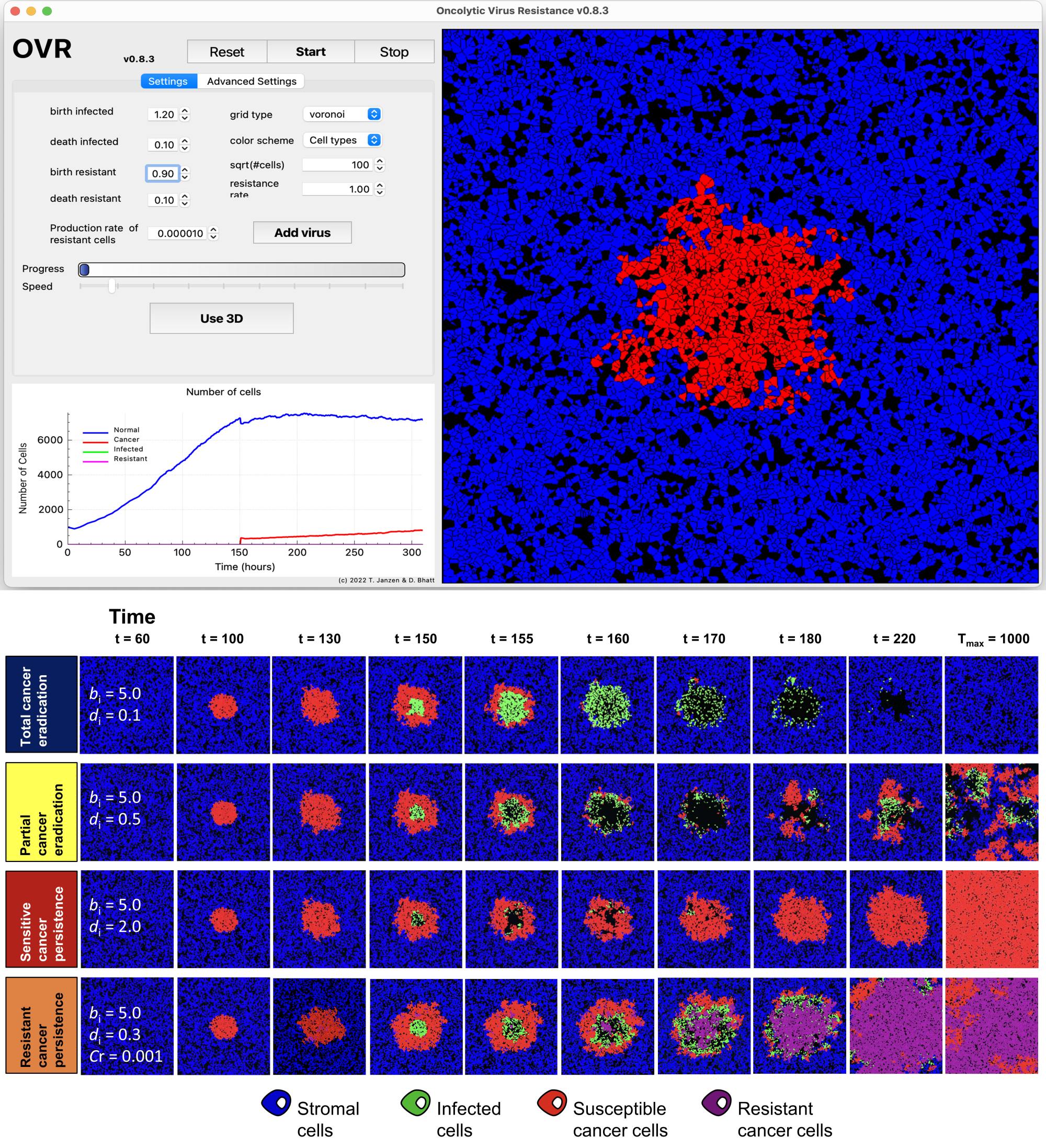
The team developed a spatial model for the complex interplay of tumour growth, the infection dynamics of viruses, and the emergence and spread of virus-resistant tumour cells. At a later stage, the responses of the immune system to both tumour growth and viral infection were added to the model. The model shows that therapeutic success and failure depend on stochastic events, implying that both can occur in replicate simulations of virotherapy. But for each setting of the parameters, the model makes clear predictions on the probability of therapeutic success. This allows studying how therapeutic success is affected by therapeutically relevant factors, such as the growth and infection parameters of the virus, the spatial configuration of the tumour, or the timing of virotherapy. The model implementation is computationally highly efficient, allowing to run many replicate simulations in a short period of time. The team has developed an executable version of their Oncolytic Virus Resistance simulator with an intuitive graphical user interface, allowing practitioners to simulate and visually observe the spatial interplay between the various cell types. This tool is highly valuable for understanding the therapeutic dynamics, as it allows to explore in silico a wide range of therapeutically relevant scenarios, thus providing new insights and ideas for therapeutic improvement. One such insight is that the properties of the tissue surrounding the tumour is of larger importance than realised until now. For this work, Bhatt received the “PhD award” at the Dutch Tumour Immunology Meeting in 2022. He is very engaged in outreach activities, as evidenced by his podcast “BenchTalks with SynBioNL” and his advisory role in the “Nanobuddy” project, which won the iGEM Groningen team a gold medal and a nomination for the best safety award in 2022.
Telomeres: Linking evolutionary ecology and the life sciences
How do we assess health? And can we predict future health and remaining life span of individual humans and other animals? This question is of interest in both evolutionary ecology and in the life sciences because biomarkers of health link development and life stress to disease risk and life expectancy. A candidate biomarker to predict morbidity and mortality is the length of telomeres, complexes of repeated DNA sequences and proteins at the end of linear chromosomes.
Telomeres have the same sequence and fundamental biology in all vertebrates, and in the research program of the Verhulst group we combine studies on humans and birds. These species have complementary qualities: birds are amenable to experimentation, and their lives are relatively short, making it possible to follow individuals over their entire life. Humans offer neither, but are of interest in their own right, and information available on individual humans often vastly exceeds what is known of individual birds, including information on diseases (e.g. Covid-19) and details on the cause of death.
Telomeres shorten with age and we showed in both humans and birds that this decline is particularly fast early in life. We find that telomere length predicts mortality in humans and birds, and it was thought that this was causally related to telomeres reaching a critical length at which cells no longer divide. However, we recently showed that telomeres reach a critical length in only a very small part of the population within the human life span, indicating that another mechanism causes the link between telomere length and mortality. This mechanism remains to be resolved, but recent work by us and others suggests that resistance to infectious diseases may drive the link between telomere length and mortality. This hypothesis is based on our finding that in hospitalized Covid-19 patients there was a strong positive association between telomere length and the abundance of T-cells, which predicts disease outcome; T-cells are instrumental in the production of antibodies and their proliferation is telomere-length dependent.
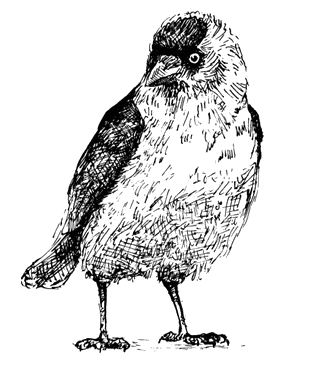
Given that telomere length predicts morbidity and mortality, it is of interest to identify drivers of individual variation in telomere length. In our long-term population study of free-living birds, using data from multiple generations and so-called ‘animal models’, we estimated that approximately 75% of individual variation in telomere length can be attributed to additive genetic effects. However, this is only part of the story. Telomere length is an unusual trait, in that the zygote already has a phenotype, namely the telomere length of the gametes that formed the zygote, and we revealed that gamete telomere length has carry-over effects on offspring telomere length later in life. Thus, telomere length can to some extent be considered a Lamarckian trait, in that changes in phenotype over life can be transmitted to offspring, who in turn can transmit the phenotype to their offspring.
Telomere length at any age is the outcome of telomere length at birth and subsequent telomere shortening (telomerase, the enzyme that among other functions can elongate telomeres, ceases to be active from early development onwards). Our long-term studies of birds and mammals have revealed that individual variation in telomere length shortening is small, and probably limited to the developmental period, and hence individual variation in telomere length is largely set early in life. We have also revealed that telomere shortening is the likely driver of associations between telomere length dependent morbidity and mortality. It is perhaps for this reason that measurements of birds of only a week old is a significant predictor of lifespan, which we consider a remarkable phenomenon. Our current research is therefore focusing on the drivers of individual variation telomere shortening in early life.
The Adaptive Brain: Neurobiological Foundations of Behaviour and Cognition
Individual differences in general coping style in rats: Face validity model for human disease susceptibility and therapeutic strategy
Preclinical research employing predominantly domesticated laboratory animals has long neglected the issue of individual disease vulnerability mainly because a reduction of individual variation through inbreeding and rigorous standardization has been the common experimental approach. However, even under highly standardized conditions it is clear that animals of the same sex and age within a given strain show consistent individual differences in their behavioral and physiological response patterns (coping style) to environmental demands (Koolhaas et al., 1999). As a matter of fact, even in highly inbred laboratory strains, genetically identical subjects may be considerably more or less susceptible to similar experimental manipulations.
Rather than viewing individual differences as a limitation or impediment to preclinical research, it should be considered a valid biological factor and focused on in any experimental animal model of human disease. The increasing acknowledgement of the biological significance of individual variation is currently starting a valuable paradigm shift in preclinical behavioral neuroscience studies, e.g., to focus more on individual phenotypic variations rather than solely on traditional group averages. For example, it appears to be essential to distinguish susceptible from resilient individuals on the basis of predefined behavioral and physiological characteristics. As a matter of fact, clinical research routinely compares select “susceptible” patient groups with “resilient” healthy subject control groups. Hence, for translational validity it is imperative to adopt this paradigm-shift to focus on and select for particular phenotypic variability.
As an example, we have employed feral WTG rats, in which we have convincingly demonstrated that individual differences in trait-aggressiveness is an adaptive component of the natural sociobiology of rodents, and highlights that these reflect the general style of coping that varies from proactive (aggressive) to reactive (docile). Emerging evidence suggests that traits such as dominance and competitive aggressiveness are linked to (pro)active coping, resulting in phenotypes believed to be more resistant to psychiatric disorders. In contrast, subordinate status, absence of aggression and passive (reactive) coping are linked to phenotypes more susceptible to adverse psychiatric outcomes (e.g., depression, PTSD). Hence, for biomedicine understanding and probing phenotypic variation is fundamental in disease susceptibility as well as in the development of newly personalized approaches to precision medicine.
We showed that this qualitative coping style can be disentangled into multiple quantitative behavioral domains, e.g., flexibility/impulse control, emotional reactivity and harm avoidance/reward processing, that each are encoded into selective neural circuitries. Since functioning of all these brain circuitries rely on fine-tuned serotonin signaling, autoinhibitory control mechanisms of serotonergic neuron (re)activity is crucial in orchestrating general coping style. Untangling the precise neuromolecular mechanisms of different coping styles will clearly provide a roadmap for developing better therapeutic strategies of stress-related diseases.
Combating the negative impact of sleep loss on brain function
It is widely acknowledged that not getting enough sleep is a common problem for both young and old in our 24/7 society due to social and economic demands. Furthermore, many neurodevelopmental disorders such as autism spectrum disorders and forms of dementia including Alzheimer’s disease are plagued by disrupted sleep and sleep loss and can even facilitate the development of dementia. Thus, there is an urgent need to define the molecular underpinnings by which sleep deprivation affects brain function and use this knowledge to develop novel strategies to support the sleep-deprived brain.
The group of Prof. dr. Robbert Havekes (GELIFES) therefore aims to elucidate the molecular mechanisms underlying memory storage and define how those mechanisms are affected by loss of sleep and in neurodevelopmental and neurocognitive disorders. Using a combination of behavioral studies, viral/transgenic/optogenetic strategies, memory engram approaches, chemogenetics, biochemistry, and pharmacology, Prof. Havekes showed in mice that even a single brief period of sleep deprivation leads to amnesia due to the loss of neuronal connections in the hippocampus, a brain area critical for spatial memories. Thereafter, he discovered that misregulation of the cAMP-PDE4A5-PKA-LIMK-cofilin pathway was at the center of these memory and structural plasticity deficits. Excitingly, targeting this pathway in a brain-region and cell-type specific fashion was sufficient to prevent the structural plasticity changes and memory deficits. Taking advantage of these fundamental discoveries, his lab successfully identified FDA-approved drugs targeting specific components of the affected signaling pathway to prevent sleep deprivation-induced memory impairments, thereby greatly elevating the translational potential of these findings.
More recently, the Havekes lab implemented optogenetic approaches and memory engram strategies to define the origin of sleep deprivation-induced amnesia. They found that in contrast to general belief, the amnesia following sleep deprivation was not a result of information loss, but rather the result of difficulties retrieving memories stored under sleep deprivation conditions. Related to this, the Havekes lab showed that such ‘hidden’ memories could be made permanently accessible again using optogenetics memory engram technologies and pharmacological manipulations using the previously identified FDA-approved drugs even days after the sleep deprivation episode occurred. Moreover, these findings underscore the now emerging and exciting view in the field of memory research that amnesia in many cases may be to difficulties in remembering information rather than the loss of the information, and that the brain may contain a lot more information than previously thought that could be made accessible again.
The importance of these fundamental findings with strong translational potential and societal relevance is underscored by the fact that the research has been financially supported by NWO, the prestigious Human Frontiers Science Program (HFSP), and the Airforce Office for Scientific Research (AFOSR). The work by the Havekes lab has received strong attention in the national and international media (e.g., Neuroscience News, The New York Post, radio shows in the UK) and provided a stepping-stone for human sleep deprivation studies at Maastricht University. Moreover, the knowledge obtained with these studies currently forms the molecular basis and ongoing collaborative efforts with the Meerlo, Kas, and van der Zee labs (GELIFES) to understand the similar mechanisms may contribute to other forms of amnesia and sensory processing misregulation in mouse models for other forms of amnesia such as Phenylketonuria (PKU) and autism spectrum disorders.
The use of mild vibrations to promote brain health
Vibrations are all around us. Both animals and humans are equipped with various sensors to detect these vibrations. In the animal kingdom, vibrations are used for communication, and the detection of prey, predators or potential mates. In the case of humans, the many vibrations around us are often not detected consciously, except for the vibrations with a high amplitude like those generated by machinery, large animals, or the weather for example. Vibrations can be used as a training method to strengthen muscles and reflexes, as is often done in sports facilities, using vibrating platforms to stand on (whole-body vibration (WBV)) while performing exercises. This raised the question of what such vibrations do to the brain, as it is known that strong vibrations applied for longer periods (>30 min) can cause physiological damage.
The group of Prof. dr. Eddy van der Zee (GELIFES) therefore aims to study the impact of vibration on the brain and its performance (e.g. cognition). A translational approach was set up using WBV to study the impact of vibrations on the rodent brain. Although it was initially anticipated to find harmful effects of the vibrations, it turned out that low amplitude, 30-40 Hz vibrations provided for brief periods (5-10 minutes) has a positive effect on the brain. This is found both at the behavioral level (cognition, mood, motor performance) and the cellular level (muscles, neurons, astrocytes, microglia, and blood vessels). Next step was to study the impact of these mild vibrations in rodent models for various brain disorders. In all cases it was found that the impact of mild WBV was positive, promoting general brain health but not so much the cause of the disease. Based on these results, we started to study the impact of WBV in humans, in close collaboration with the UMCG and Experimental Psychology, with emphasis on neurodegenerative diseases like Alzheimer’s and Parkinson’s disease.
In 2016 we started a national society of researchers working on WBV, called WAVEX (World Association of Vibration Exercise Experts). Since then I have been the president of this society, which has now ca. 120 active members from around 15 different countries worldwide. We organize (bi-)annual meetings to promote WBV research and spread of knowledge. We use WAVEX to initiate the writing of joint papers (often via special issues) and started to set up a journal dedicated to WBV (BJMVB) with several WAVEX members in the editorial boards. A joint WBV guideline paper was published in 2021 where GELIFES/RUG took the lead, and these papers set the standard on how to report WBV studies. This paper is already well-cited.
Recently, the van der Zee lab started to study the impact of vibrations in the environment (e.g. urban versus rural) in isopods which can be a fruitful area for collaboration between the different GELIFES expertise groups. Over the years, WBV has been a subject used to illustrate the relevance of translational research in various outreach activities, either via WAVEX or individually. The societal relevance of WBV is high, as it is a feasible, cheap and quick therapy that can be used safely by subjects who cannot benefit from exercise therapies, for example due to physical problems, mental problems or brain disorders. Challenge is to determine the optimal settings and protocols. To determine this, the van der Zee lab is currently examining the impact of a variety of settings in several (simple) animal species, and tries to further identify key pathways in body and brain which are essential for the positive effects on brain health. Finally, the evolutionary origin and relevance of vibration detection in the animal kingdom, especially in humans, and its health-promoting features, is an area that needs to be further explored.
Personalized prevention of non-communicable disease
The global prevalence of non-communicable diseases (NCDs), including chronic heart failure, diabetes, cancer and chronic respiratory disease is increasing drastically. NCDs are a major burden on society, with the loss of many healthy life years and the accompanying increasing health-care costs. Risk factors for NCDs are several cardiovascular and metabolic derangements, including raised blood pressure, abdominal fat storage, overweight/obesity, hyperglycemia and hyperlipidemia. These appear to result from an unhealthy lifestyle, characterised by eating an unbalanced diet and unhealthy behaviours (including sedentariness, sleep restriction, substance abuse, etc). Apart from these changes, aforementioned NCDs are also frequently preceded by (often vaguely perceived) somatic and mental symptoms, like chronic fatigue/exertion, headache and abdominal pain, independent of classic risk factors, such as high body mass index (BMI) or physical inactivity. In addition, somatic and mental symptoms also predict subsequent health status and health-related quality of life, independent of several adverse life events that happened earlier. For this reason, the van Dijk group focused on the question how certain life style parameters of individuals not (yet) diagnosed with an NCD are related to somatic and mental symptoms, and whether and how personalized alterations (rather than a “one-size-fits-all” approach) in dietary intake patterns and related behavioral changes could reduce these symptoms.
For this purpose, we developed the health platform “Eating for Science” to allow “at risk” participants to choose and execute their own lifestyle intervention of which they think would suit them best in terms of health impact and adherence. In addition, we developed algorithms and a mobile app to record alterations in dietary intake patterns and behavioral parameters as well as changes in mental and somatic symptoms. Principal component analysis revealed that reduction in mental symptoms was explained by increased physical activity and increased intake of the “Wheel of Five” (i.e., Schijf van Vijf) dietary pattern. Reduction in somatic symptoms was most prominently explained by reduction of the “Processed Foods” dietary pattern (Willems 2022, 10.1016/j.pmedr.2022.102004). Several spin-off projects are currently being carried out (including an SNN-funded research project Eten voor de Wetenschap 2.0 to prof. van Dijk) to investigate whether baseline characteristics (such as the personality profile of participants) and trackability of health records, can explain the efficacy of a self-chosen lifestyle intervention for reduction of somatic and mental complaints. The long-term goal is to come to personalized lifestyle intervention strategies (based on personality and somatic/physiological characteristics), with the highest efficacy and adherence to prevent development of NCDs.
Societal Embedding
The Dutch nitrogen crisis: A key role for scientists in the public debate

After the first warnings by scientists around 1980, the past 40 years have shown a strong increase in the negative impacts of atmospheric deposition of nitrogen on natural ecosystems. As a result, diversity of plants and various insect groups and birds characteristic for nutrient-poor ecosystems as fens, bogs, heathlands and diverse grasslands has strongly declined. This increasingly conflicts with the international agreements, now embedded in national law, that the Netherlands has made in the context of the EU Birds and Habitats Directives. In this context, the Dutch government has legally guaranteed the persistence of a range of characteristic species of nutrient-poor ecosystems in habitats protected under the Natura 2000 framework. However, key conservation and restoration goals have been poorly achieved yet. A major source of anthropogenic nitrogen deposition over the last decades has been the emission of ammonia from the livestock industry, especially dairy farms, where insufficient reductions through technical measures have been taken to save the nutrient-poor ecosystems of our country, due to continuous lobbying from agricultural sector combined with poor political enforcement of existing regulations, where emission permits were granted for farm expansions only based on the promise of future innovations. In 2019, based on a lawsuit filed by a group of environmental organizations, the highest court of the Netherlands ruled a negative verdict on the government nitrogen policies until then. This led to a direct ban on all larger construction activities in the Netherlands, such as housing or road constructions (as these also emit nitrogen, as NOx), or any new agricultural activities (farm expansions, etc.). This "nitrogen crisis" remained largely unsolved by the government, until a new cabinet that was formed in march 2022 came to an agreement to now really tackle the problem. In June 2022 the government launched the "National Rural Area Program" (NPLG) in which drastic emission reductions were decided, to be further worked out by the provinces to be ready by 1 july 2023. This led from july 2022 onwards to massive farmer protests, some violent, that drew international media attention and are still ongoing (march 2023).
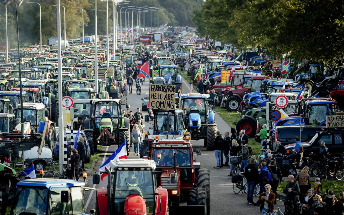
Since June 2022, prof. Han Olff rose in the media as a spokesperson on behalf of the national scientific community on the soundness of the scientific basis for more stringent policies on nitrogen emissions. He led an opinion paper in a national newspaper of 36 Dutch leading scientists in the field of ecology and agricultural sciences. The article argued that there is strong scientific consensus on how emissions and depositions of nitrogen and the ecological sensitivity of ecosystems to this are calculated. And, that "calls for more research due to scientific uncertainties" by various politicians and agricultural organizations should therefore be interpreted as mostly reflecting delay tactics, rather than true interest in scientific progress. His subsequent frequent media appearances on the subject (see table below) focussed often on explaining to the public the intrinsic relations between scientific progress, scientific doubt and critique, consensus on certain topics and intensification of research on the new and remaining questions. He is also frequently involved as a 'fact checker' in the debate to debunk false interpretations of scientific evidence. His twitter account has close to 5000 followers, ranking him in the top 10 of University of Groningen social media outreach on this platform, with a total count of 2 million Twitter impressions for March 2022 - Feb 2023, reflecting a commercial outreach value (if it would represent advertisement impact) of 7 million Euro.
| Date & link | Media type | Media | What | Message |
|---|---|---|---|---|
| 07-03-23 | National television | OP1 talkshow | Expert comments | Negative impacts of nitrogen on nature still not solved |
| 18-02-23 | National newspaper | Trouw | Opinion paper | Use rewilding to fight the nitrogen crisis |
| 06-11-22 | National news site | Groene Ruimte | Opinion paper | Robust nature provides perspective for farmers |
| 06-10-22 | National newspaper | Trouw | Expert comments | Remkes' report is a possible gamechanger |
| 05-10-22 | Regional television | TV Noord | Interview | Policy action is urgently needed in the nitrogen crisis |
| 03-09-22 | National television | Nieuws-uur | Interview | Technological innovation cannot solve the nitrogen crisis |
| 22-08-22 | National television | OP1 talkshow | Interview | Strong scientific consensus on Dutch nitrogen crisis |
| 22-08-22 | National radio | Dit is de dag | Interview | The scientific evidence on nitrogen impacts is solid |
| 21-08-22 | National newspaper | Trouw | Opinion paper | 36 scientists: stop casting doubts on nitrogen crisis |
| 10-06-22 | Scientific journal | Science | Letter | Nitrogen availability increases despite climate change |
Changing Dutch policy for seal pup rescue by behavioural biology research

After a period in which the population of harbor seals in the Wadden Sea flourished, the population crashed due to hunting and virus diseases in the second half of the previous century. In that period a series of seal centres were established along the Dutch coast (as well as in Germany and Denmark) to rehabilitate abandoned pups and diseased seals. This has continued until now, despite the fact that, due to protection measures, the population recovered and is currently estimated at carrying capacity level for the available habitat. As a consequence, seal rehabilitation centres were until recently often full of pups during late spring and the beginning of summer that were fed and if needed treated with medicines, after which they were released in the Wadden Sea at independence.
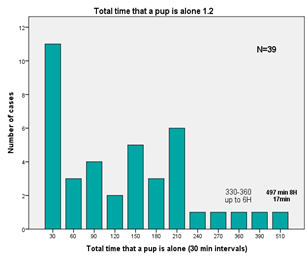
Despite a lot of support from the general public for this rehabilitation strategy, there were no data at all about the need for taking in that many so-called abandoned pups. The guideline was determined offhand, such that pups that were without a mother for more than 2 hours should be taken in. This was under the conviction that mothers never left their pups alone. However, as mothers invest heavily in milk production, and need to feed themselves during the 3-week lactation period to compensate and keep milk production at a sufficient level, this conviction seemed unlikely. Moreover, separating pups from mothers was likely to result in heavy stress for both, and sufficient data on survival of pups released after the rehabilitation period were lacking.
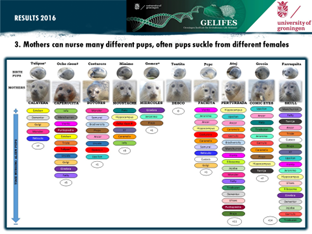
Therefore, Beatriz Rapado Tamarit and Margarita Méndez Aróstegui, two PhD students under the supervision of prof. Groothuis started to do observations on mother-pup interactions at the Sealcentre in Pieterburen at the North coast of Groningen, over multiple years and using state of the art photo-identification software. They discovered that mothers can leave their pups for much longer than 2 hours, often 8 hrs and up to even 12 hrs, with the pups surviving and the mother returning in all cases. Moreover, they found for the first time that during lactation a system of communal suckling was in place, with most mothers on the study allowing up to even 16 pups to feed. They also observed a few cases where the pup was taken away, resulting in the mother being highly stressed and searching for her pup for several days in a row. Together with the fact that most pups were in relatively good condition when taken in, and that survival data on released seals were mostly lacking, we argued that the guidelines for taking in pups should be revised and severely restricted. This caused fierce discussion in the media and among seal centres, and we were regularly interviewed in radio shows and newspapers. As a consequence the under-minister for agriculture, nature and food quality implemented an international advisory committee. Strongly based on our data, the committee advised indeed for a strong limitation in the criteria for taking in pups, which was presented, discussed and agreed on in parliament in 2018. This radically modified the practice of pup rehabilitation in the Netherlands.
Nature conservation partnerships
The Conservation Ecology expertise group at GELIFES has a strong track record of collaborating with organisations that are involved in nature conservation. This partnership is established through various means such as funding of research projects, joint research and dissemination projects, and the involvement of CONSECO staff members as board members of these organisations. One example of this collaboration is the long-term ecological research being conducted on the island of Schiermonnikoog, which has been ongoing for the past 40 years. This research involves bi-annual meetings with representatives from Natuurmonumenten, The National Park Schiermonnikoog, Gemeente Schiermonnikoog, and the province of Friesland to discuss research plans, management concerns and disseminate findings in the Coordination Committee Scientific Research Schiermonnikoog (CCWO).

CONSECO also has a strong partnership with Natuurmonumenten, which includes involvement in two large research projects over the past 10 years. The first project, Waddensleutels, focused on understanding the impact of ecosystem engineers such as mussels and cockles on intertidal mudflats on other organisms such as birds and fish. CONSECO was responsible for the research aspect of the project while Natuurmonumenten handled project organization, management, financial reporting, and communication of results to society. The second project, Waddenmozaiek, is also funded by Waddenfonds and involves collaboration between CONSECO, NIOZ, and Natuurmonumenten to understand key ecological processes in the sublittoral Wadden Sea. CONSECO has also made significant contributions to the field of agroecology and nature-inclusive agriculture. Pablo Tittonell, an affiliate professor in this field, was funded by WWF Netherlands for five years to promote knowledge development in this area. This led to his full-time appointment in the same field at the institute on regular university funding. Theunis Piersma was funded by Vogelbescherming and WWF for 10 years in the chair Global Flyway Ecology. In this role he made large contributions to the preservation of intertidal mudflats in East Asia.

Moreover, CONSECO's staff members have been highly involved as board members in various conservation organizations. Christiaan Both serves as chair on the scientific advisory boards of Vogelbescherming Nederland and SOVON, while Chris Smit is on the societal board of Staatsbosbeheer. Han Olff has served as a board member for WWF Netherlands, Ark Natuurontwikkeling, and is internationally involved in the Greater Serengeti Conservation Organization in Tanzania, the One Mara Research Hub in Kenya, and the Parc National du Banc d'Arguin in Mauritania. Raymond Klaassen is a board member of Het Groninger Landschap, and Theunis Piersma is on the societal board with It Fryske Gea. Pablo Tittonell is involved with the CGIAR International Commission on Sustainable Agriculture Intensification and the Intergovernmental Panel on Biodiversity and Ecosystem Services. This active involvement in the governance of nature conservation organizations demonstrates the high value placed on the expertise of CONSECO's staff members in this field. It also highlights the group's commitment to applying their research findings to real-world conservation efforts and making a tangible impact on the ground.

Finally, the group has engaged in a wide range of ecological field projects that involve close collaboration with conservation managers on the ground in different protected areas in the Netherlands and abroad, such as Laura Govers in the field of seagrass restoration together with Natuurmonumenten and Rijkswaterstaat, Theunis Piersma on the alternative farming practices to preserve meadow birds, and Han Olff in the restoration of the Markerwadden with Natuurmonumenten. Overall, CONSECO has a strong commitment to advancing the field of nature conservation through collaborations with relevant organisations and by conducting research that can inform conservation management practices.

The story of BirdEyes
Developing a centre for global ecological change at the Faculties of Science & Engineering and Campus Fryslân

BirdEyes is a science and creative centre that views the world - almost literally - through the eyes of birds. As more birds fly around with tiny transmitters, loggers and other advanced technology, an unimaginable amount of information is generated on what makes birds tick. By cleverly combining such data with other sources of information, and by using new ways to tell stories and share the insights with, BirdEyes strives to open up a new knowledge network. The centre aims to be an innovative part of the University of Groningen, with empirical and inspirational roots in the farthest corners of the world.
Long tradition
Using the figurative eyes of (migratory) birds to expose and tell relevant ecological stories, we build on a deep Dutch tradition of in-depth research on the living conditions of coastal and meadow birds. We also build on the ever-increasing possibility to follow those birds around the globe by means of small transmitters. BirdEyes is the spin-off of a growing CONSECO group of GELIFES, offering new space for science and scientists, invigorated by the complementary interests at Campus Fryslân.
Examples
Birds become our eyes on the world. Tagged godwits in the meadows of Friesland appear to have a predictive gift in finding the grasslands that were most resistant to drought later in the year. Red knots and bar-tailed godwits show climate change affecting their remote arctic breeding grounds. By their movements and breeding success, spoonbills show the presence and abundance of small fish.

Expertise and interaction
Some ecologists may know a lot about birds, but they are unlikely to know about the many many human economic, social and cultural issues entanglements. We seek to ensure that ecologists connect with people who have an understanding of societal issues that touch on the ecological problems. Individuals who have been thinking about issues all their lives from their own practice as engaged farmers, journalists, entrepreneurs, artists, sociologists, elementary school teachers, philosophers, veterinarians or potato growers.
Collaboration
BirdEyes is an experimental collaboration between the Faculties of Science & Engineering and Campus Fryslân, from which close work relationships will be developed with kindred spirits at NIOZ Royal Netherlands Institute for Sea Research, the University of Amsterdam and Fryske Akademy. Our teaching focuses on PhD students and postdocs, especially in the form of summer schools.
Located in Leeuwarden, BirdEyes stands for an interactive attitude. To be able to see the forest for the trees we maintain a sharp focus from that integrating bird's eye view.
Neurobiology and industrial partners
The Neurobiology group of GELIFES studies the adaptive nature of animals (including humans) to deal with opportunities, challenges and threats in the environment, as well the maladaptive consequences that may occur if changes in the environment are beyond the capacity of animals to cope with these changes. Maladaptive consequences often underpin the development of certain pathologies, with many striking examples of human diseases in the current 24/7 society. Neurobiology PIs have access to unique facilities where they study human and animal fundamental processes of sleep, ingestive and affective behavior, social functioning, learning and memory formation, circadian rhythms, as well as the pathological changes that can occur in these behaviors. As such, the engagement between the neurobiology group and industrial partners offer opportunities to spur innovation and societal impact. In the past years successful frameworks between neurobiology PIs and industrial partners have been set up or intensified for the following topics:
1) Nutrition and development
In collaboration with Nutricia Danone (the Netherlands) the van Dijk lab studies fetal programming effects on energy balance regulation, and how early dietary interventions could reduce the risk of cardiometabolic derangements later in life. Dietary interventions in relation to preclinical studies in phenylketonuria, a metabolic disease causing brain dysfunction already at early age, are performed in the van der Zee lab with food companies Nutricia Danone (the Netherlands), Vitaflo International (Germany), Arla Foods (Denmark) and PTCBio (USA).

2) Passive exercise and motion simulation
Collaborations in the field of passive exercise and motion simulation as interventions to promote health in both rodents and humans are done with various types of medical equipment made available by NovoTec Medical (Germany), Marodyne Liv (USA), and Pactive Motion (the Netherlands). This approach is being used in the van der Zee lab in the context of brain stimulation (neuro-exercise), neurodegenerative diseases, healthy aging and recovery from surgery.

3) Social and cognitive functioning in brain disorders
As project coordinator of the nationally funded ZonMW memorable and EU funded PRISM1 and PRISM2 projects, Prof. Kas worked on transdiagnostic and translational research with respect to social and cognitive functioning in psychiatric disorders and dementia with Janssen Pharmaceutica (Belgium), and with Eli Lilly and Company (UK), Boehringer Ingelheim Pharma GmbH & Co KG (Germany), Novartis Institutes for Biomedical Research (Switzerland), Roche (Switzerland), Takeda (Japan), and Janssen Pharmaceutica (Belgium), respectively. In these projects, a total of 2 postdocs and 7 PhD students were hired in Groningen, and provided a number of collaborative publications. In collaboration with Atlas Pharmaceuticals (Belgium) new drug targets are tested for their effectiveness in treating premature ejaculations, a common sexual complaint, in the Olivier lab. A post doc, technician and the project costs were financed by Atlas Pharmaceuticals. In collaboration with Psychogenics (USA) potential drug targets were tested for their anti-aggressive properties in the de Boer lab which is followed up in the Olivier lab. Psychogenics financed a technician and project costs.

4) Biological rhythms and sleep
Chronobiology has a strong societal relevance for health and biodiversity. The chronobiology spin-off company Chrono@Work, led by CEO dr. Marijke Gordijn, has led to stable collaboration projects bridging between industry and fundamental research EUHorizon2020 ‘EnlightenMe’, EUinterreg Food2020 ‘NiteBite’, PCH EcoSystems ‘SleepInSync’, PBM Seaborough. Prof Hut, Prof Meerlo and Chrono@Work have close collaborations with lighting companies, industry (shift work), and policy makers. Seaborough finances 2 projects (1 publication), Philips co-financed the ‘Energy4All’ project (1PhD, 6 publications). Within the NWO/NWA project BioClock, Prof Hut (board member) and prof. Meerlo collaborate (together with LUMC, UVA, Erasmus) with 13 companies and 5 associations (MediLux, GoodLightGroup, DarkSkyAssociation, Agricultural Associations), 10 governmental policy organizations (city, province), and 10 Knowledge and Health Care associations. In total 4 PhD students are financed at GELIFES. Collaborations between Chrono@work, Prof. Hut and lighting companies (Philips Lighting, Signify, Peira, Exmore, Seaborough) led to several projects where novel light applications and spectral adjustments were tested for health benefits. In addition, hibernation research (with Henning, UMCG) has led to spin-off products marketed by Sulfateq BV (Groningen).

5) Neuroimmune modulation of neurodegenerative diseases
By using modulators of the Tumor Necrosis Factor receptors the Eisel lab investigated in preclinical models of Alzheimer’s disease and Multiple Sclerosis the ameliorating effects of either TNFR1 antagonists and TNFR2 agonists in mouse models and humanized TNFR mouse models. The Eisel lab is collaborating on these models with BioNTech SE (Germany) and Baliopharm (Switzerland). One Postdoc was supported by BioNTech SE. The Eisel lab also investigates the use of cAMP signaling molecule Epac2 in improving memory retrieval by the use of a selective agonist provided by Biolog (Germany).

Leadership in EU-funded Innovative Medicine Initiative consortia
The development of treatments for neuropsychiatric conditions, such as Alzheimer’s disease and Major Depressive Disorder, forms one of the major challenges of our time in public health. According to the World Health Organisation report on priority medicines, neuropsychiatric conditions rank third on mortality for the EU and rank second on burden of disease as measured in disability, adjusted for life years. The research of Prof. dr. Martien Kas (GELIFES) aims to develop a quantitative, transdiagnostic neurobiological approach to the understanding of neuropsychiatric disorders in order to accelerate the discovery and development of better treatments for patients with those disorders. The ability to precisely link neuropsychiatric symptoms to underlying neurobiology will not only facilitate the development of better treatments, it will also allow physicians to provide patients with a better understanding of the complexities and management of their illness. To realise this ambition, he has introduced a paradigm shift that is needed to raise awareness and to build an understanding of how neuropsychiatric diagnoses can be based on quantitative biological parameters. As project coordinator of two major EU funded projects (total budget of 24 million euro), Prof. Kas has implemented this innovative strategy that also allows for back translation of human quantitative findings to animals to expand our knowledge of the underlying neurobiological mechanism and to facilitate the drug discovery process.
These two large EU consortia, funded through the Innovative Medicine Initiative (IMI), include partners from leading European academic centres, patient-family organisations, and large pharmaceutical companies (such as Eli Lilly, Boehringer Ingelheim, Novartis, Roche, Takeda, Janssen Pharmaceutica). The recent granting of the PRISM2 project was based on the successful implementation and management of the PRISM1 project under his leadership.
Novel technologies have been implemented by Prof. Kas to stimulate this innovative approach, including a smartphone application to assess real world daily social functioning. This digital innovation from his research group has led to new national and EU consortia grants, such as the ZonMW memorable project that he leads on social health in dementia, the IMI ROADMAP project, and the Horizon2020 funded PSY-PGx project. As part of the PRISM2 project, Prof. Kas and his team are now generating a regulatory report that will be submitted to the European Medicines Agency (EMA) for a scientific advice opinion for a digital endpoint for social functioning which they developed and validated. Furthermore, he is a leading expert in animal studies to investigate neurobiological mechanisms relevant for neuropsychiatric disorders. In that role, he is currently involved in four major national and EU projects targeting neuropsychiatric disorders, including the IMI Aims-2-trials project, a 113 million euro grant on Autism Spectrum Disorders, and the Horizon2020 funded CANDY project.
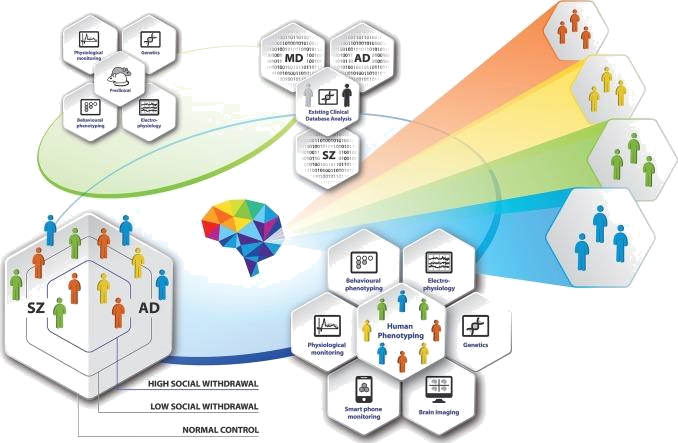
Research-oriented Education
Excellent research-oriented educational programme: Erasmus Mundus Joint Master in Evolutionary Biology (MEME)
The Erasmus Mundus Master Programme in Evolutionary Biology (MEME) is a world-renowned educational programme in evolutionary biology delivered by five European universities that have joined their complementary forces (with Harvard as Associate Partner). The University of Groningen, and specifically GELIFES, is the coordinating institution of the MEME programme and houses the central MEME Office, which includes the MEME director (currently L.W. Beukeboom, and previously F.J. Weissing).
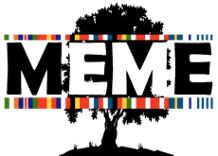
MEME is a two-year research-oriented MSc programme for talented and motivated students interested in understanding evolution and its application. The focus is not only on how evolution shaped life on our planet in the past but especially on how understanding the principles underlying evolution can provide new insights for present-day challenges in a variety of fields, including ecology (global change, biodiversity crisis), epidemiology (pandemics), genetics & genomics (big data science), medicine (Darwinian medicine), economics (evolutionary algorithms), agriculture (biological control, pest management) and the social sciences (cultural evolution, evolutionary psychology).

MEME recruits students from all over the world and is designed to provide optimal preparation for a subsequent PhD trajectory and eventually a career in academic and non-academic research. In line with this goal, the emphasis is less on teaching textbook knowledge but on motivating the students to explore knowledge gaps and the current borders of our knowledge. To this end, students are offered the opportunity to compose a highly flexible and individually tailored study programme. The students are exposed to the latest scientific insights, use state-of-the-art techniques and facilities, and are embedded in a high-quality international network.
MEME students have to study at several partner universities, where they are embedded in local MSc programmes. In the end, they graduate from two MEME universities. Most students (>85%) graduate in nominal time, typically with high marks. About 90% of the graduates find PhD positions at leading research institutions, and students of the first cohorts are now acquiring academic positions, including professorships. Some alumni pursued and found positions outside academia, such as in industry and governmental agencies.
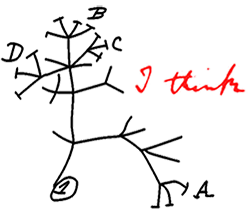
Several MEME alumni have acquired prestigious prizes. For example, Stefany Moreno-Gamez (who did her PhD at GELIFES) won a L'Oréal-UNESCO For Women in Science Award in 2019, the John Maynard Smith Prize of the European Society for Evolutionary Biology (ESEB) in 2021, and the SciLife Prize of the journal Science in 2022. Some MEME graduates have impressive research output, with publications in journals like Nature, Science, or PNAS. They also regularly initiate contacts and collaboration between their new research environment and their former MEME supervisors. Such MEME-mediated extension of research networks has several times proven to be relevant, e.g. in the formation of research consortia applying for major EU grants.

The MEME students and alumni are not only excellent researchers but also conscious members of the global society. Together with other students from their network, they initiated and developed a crash course on Evolutionary Biology in order to help prospective students from the global south achieve a better understanding of the field and increase their chances of having access to high-level master's programmes and an opportunity at a career as future evolutionary biologists. Many members of the team worked or are currently working on their Master’s or PhD research projects in GELIFES. For the first edition (in 2022), 710 students from 62 countries registered (about 1/4 from Africa, 1/3 from South America, 1/3 from Asia and the remainder from Europe/North America), of which a large group were very active participants. The course was very well received and the next edition will be organised in the summer of 2023. The team is currently also organizing a mentoring program for prospective students. The effort is supported by MEME and sponsored by the Equal Opportunities Initiative Fund of the European Society for Evolutionary Biology and the Inclusion, Diversity, Equity, and Access (IDEA) initiative of the Society for Molecular Biology & Evolution.
PhD project: Animal behaviour, computational models and bird strikes
Dr. Marina Papadopoulou's research on animal collective behaviour, involving analysis of behavioural data, computer simulations, complex systems theory, and real-world applications, is a great example of highly multi-disciplinary and valuable research in the Theoretical Research in Evolutionary Life Sciences cluster of GELIFES. The PhD project of Dr. Papadopoulou was part of the research project of Prof.Dr. Charlotte Hemelrijk: ‘Preventing bird strikes: Developing RoboFalcons to deter bird flocks'. The project involved another PhD student, Rolf Storms, who used a remotely-controlled robotic falcon in the field to test its effectiveness in driving flocks away from areas in which they act as pests, with a focus on airports and air bases. Using the data from the fieldwork, Papadopoulou developed realistic computer simulations, based on principles of self-organisation, to predict the response of bird flocks in the attacks of the RobotFalcon and propose the best pursuing strategies to herd the flocks towards a preferred direction (e.g., away from the runways). The scientific knowledge on the collective escape of bird flocks has been published in several high-impact journals and presented at international conferences, while many international companies expressed their interest in using the RobotFalcon in airports. The computer simulations of Papadopoulou, apart from their scientific significance in the theoretical field of self-organisation in social systems, will further be used to train future pilots of the RobotFalcon in the industry.
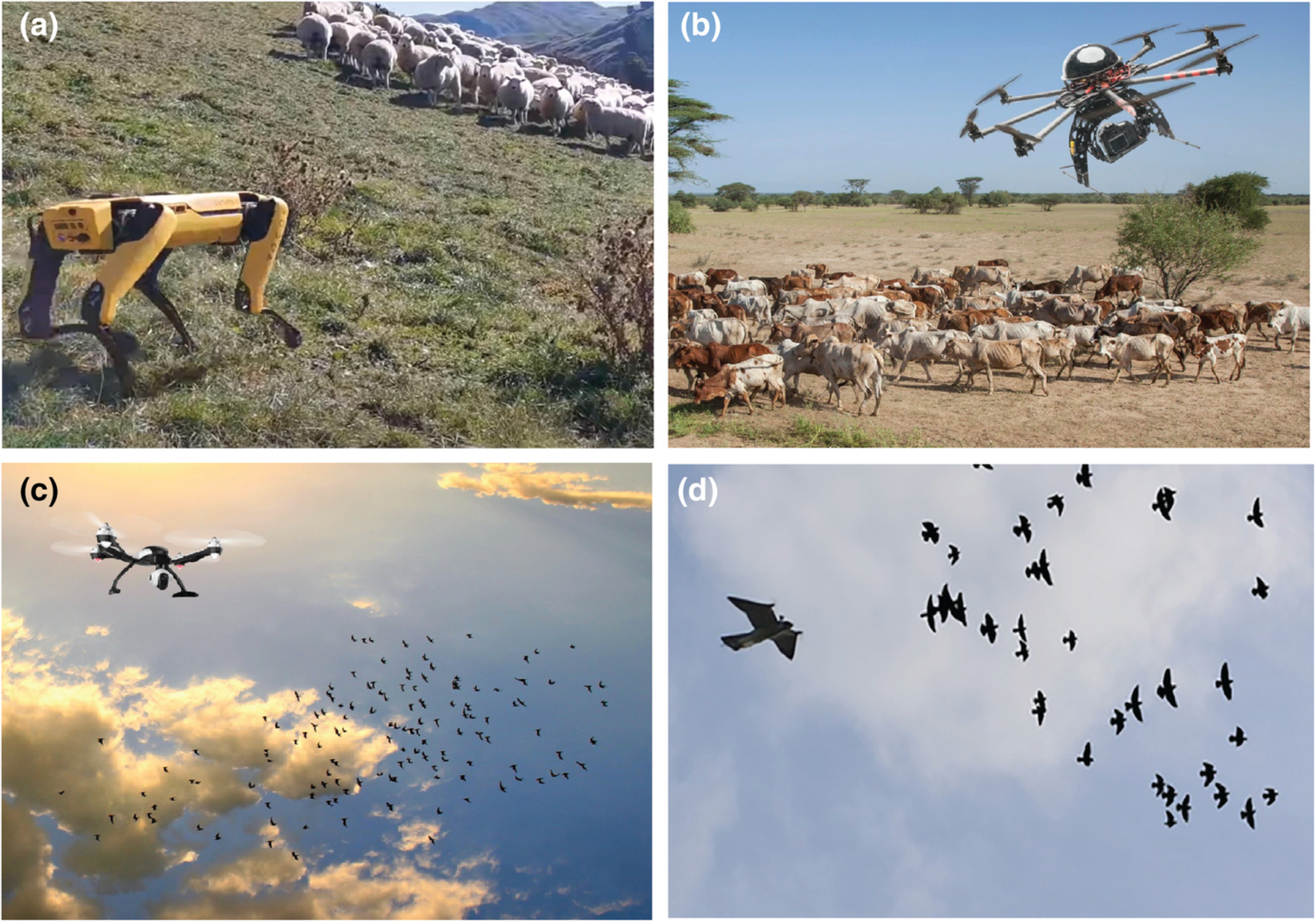
Dr. Papadopoulou is continuing her research in Swansea University (UK) in a highly interdisciplinary project, funded by the Office of Naval Research, involving animal collective behaviour of many species and bio-inspired swarm robotics, with many international collaborations including groups at Delft Institute of Technology, Oxford University, Imperial College London, and New Jersey Institute of Technology. She keeps her focus on using new findings on the collective motion of animal groups to control their movement using robots; a process that she and her collaborators recently termed ‘bio-herding’. At societal level, the applications of such practices are vast, from animal conservation to solving human-wildlife conflicts. Despite receiving her degree just in 2022, Papadopoulou is supervising 2 new PhD students at Swansea university in 2023, in projects concerning swarm robotics and bio-herding. Her PhD research at GELIFES was the first bio-herding attempt on the air, pioneering the multi-disciplinary approach that is necessary to achieve such a challenging task.
PhD project: Microbial ecology and evolution
Dr. Moreno-Gámez carried out her Master’s studies at GELIFES in 2013 as part of the Erasmus Mundus Programme in Evolutionary Biology. Then, she stayed for a PhD in the Theoretical Research for Life Sciences (TRES) group where she developed a project covering a large breadth of topics in microbial ecology and evolution - from the physiology of starvation in bacteria to the origins of quorum sensing and the evolution of antibiotic resistance. During her PhD she was also highly involved in educational activities in our department as a teaching assistant of seven different courses in programming and mathematical modeling for both undergraduate and graduate students.
A signature of Dr Moreno-Gámez’s research was the combination of computational and mathematical modeling with experimental work. Such an interdisciplinary approach was possible during her PhD thanks to collaborations that she initiated with research groups specializing on experimental microbiology. This started at the University of Groningen through a collaboration with the Veening lab at Molecular Genetics and continued with a two year stay at ETH Zurich in the group of Martin Ackermann, where she worked on developing novel microfluidic technologies to study bacterial physiology at the single-cell level. Dr Moreno-Gámez’s work has shown how phenotypic heterogeneity can help bacteria cope with antibiotics even in the absence of genetic resistance. Furthermore, it has also shown how bacteria integrate different types of cues to control quorum sensing which has led to an alternative functional interpretation of this phenomenon. All this work has led to various publications in journals including PNAS and Nature Communications as well as presentations at several meetings and conferences in The Netherlands and abroad.
Dr Moreno-Gámez’s work has also been recognized with several awards and prizes. In 2019 she won one of the L'Oréal-UNESCO For Women in Science Awards in The Netherlands and two years later she got the John Maynard Smith prize from the European Society for Evolutionary Biology (ESEB). As part of this prize she gave the JMS 2021 lecture at the last ESEB congress in Prague and received an invitation for a stay at the Institute for Advanced Study in Berlin (WiKO). Last year she also received one of the Science & SciLifeLab Prize for Young Scientists for an essay that she wrote about her PhD work entitled ‘How bacteria navigate varying environments’ which was published by Science. Currently, Dr Moreno-Gámez is a postdoctoral researcher at MIT working on the human gut microbiome with the support of the Dutch Research Council through a Rubicon grant and the James S. McDonnell Foundation.
| Last modified: | 12 February 2025 10.20 a.m. |
